- Home Start here...
- Light Fixed-Wing Aircraft
- Helicopters
- Hot-Air Balloons
- Microlights, Hang Gliders and Paragliders
- Tethered Helium Balloons
- Helium Blimps
- R/C Helicopters
- R/C Hot-Air Balloons
- Telescopic Masts
- Near-Space Photography
- Photogrammetry
- Safety and Motion Sickness
- Perspective Control
- Traditional
- Composition
- Reflections
- Digital Cameras
- Photomicrography
- The Creative Genre
- Bokeh Photography
- Essay Basics
- Image Sequences
- Time Lapse Photography
- Advertising
- Artistic Nudes
- Form and Geometry
- Glamour and Erotic
- Wildlife Photography
- Documentary
- Environmental
- Unconventional Work
- Pin-hole Photography
- X-ray Photography
- High-Speed Work
- Audio Visual
- Getting Started
- Typical Subjects
- The History of Travel Photography
- A Basic Approach
- Practicalities
- Dream and Reality
- Preparation, Travel and Arrival
- The Holiday Challenge
- Themes and Environments
- Making it Happen
- Street Photography
- Urban Landscape Work
- What is it?
- Examples of Vernacular Photography
- Everyday Family Photography
- Mobile Phone Photography
- Artistic Aspects
- Environment
- Reality and Truth
- Digital - General
- Digital Calibration and Characterization
- Digital Image Enhancement
- Digital Noise
- File Formats and Image Compression
- Colour Temperature
- Traditional Books
- Print on Demand
- Presentation
- Exhibitions
- Content Management Systems
- Search Engines
- Photographing Movement
- Memory Cards
- Distinctions
- Image Evaluations
- Inspiration
- Qualifications
- The Origins of the Society
- The Society and You
- The Society's Seal
- Liability Disclaimer
- Privacy Policy
- Society Membership
- Profiles List
- Books by OPS People
- Submissions
- OPS Exhibitions
- The OPS News Magazine
- Copyright of Website Images
- Terms and Conditions of Use
- All Products
- Distinction Fees
- Print Sales
- Returns Policy
- Terms of Service
- Shopping Cart
- Sun Position Calculator
- Sun Angle Calculator with Help
- Blue Hour Calculator
- Moon and Sun Position Calculator
- Moon Exposure Calculator
- Lunar Eclipse Shutter Speed Calculator
- Lens Focal length Calculator
- DOF Calculator
- Colour Picker
- Scientific Calculator
- Decimal to Binary Converter
- Numbers Converter
- Great Circle Distance Calculator
- Global Timezones Clocks
- Global Timezones Map
- Temperature Converter
- Panorama Production Calculator
- Distance Converter
- Decimal Degrees Calculator
- Characteristics
- File Download Time
- Human Reaction Time Test
- Interval Timer
- Testimonials
- Starting a Photographic Society
- Model Release Forms
- Introduction
- Special Cases
- When Stopped
- Rights Card
- US Tides and Water Levels
- Global Tides
- Local Weather Forecast
- Current Moon Phase
- World Time Zones
- Global Climate Data
- Sunrise and Sunset
- Global Weather Information
- Digital Manipulation
- Mobile Phone Galleries
- Monochrome Galleries
- Portraiture
- Studio Galleries
- Wedding Portfolios
- Body Painting
- Colour Infrared
- Computer Generated
- Dragonflies
- Historical Galleries
- Monochrome Infrared
- Spherical Panoramas
- On-line Exhibition 2008
- Print Exhibition 2008
- On-line Exhibition 2009
- On-line Exhibition 2010
- Northern Legacy Exhibition
- On-line Exhibition 2014
- Personal Galleries
- People and Places
- Picture Tales
- Finding a Wedding Photographer
- Pre-requisites
- Meeting the Couple
- Pre-wedding Shots
- Location and Setting
- The Wedding Day
- Hints and Tips
- Post-wedding Shots
- Album Design and Layout
- Private Images
- Private Albums
- Public Portfolios
- Private Functions
- Introduction to Distinctions
- OPS Distinctions Handbook
- Distinction Applications
- Distinctions Support
- Distinctions Calendar
- Distinction Categories
- Category Descriptions
- The Certificate of Merit
- The Licentiateship
- The Associateship
- The Fellowship
- Terms and Conditions
- Successful Panels
- Photography
- Genres (A - M)

What is a Good Narrative Photo Essay?
- " onclick="window.open(this.href,'win2','status=no,toolbar=no,scrollbars=yes,titlebar=no,menubar=no,resizable=yes,width=640,height=480,directories=no,location=no'); return false;" rel="nofollow"> Print
Early photographers quickly realized that an image could be worth 1,000 words - and in some cases many more. Words evoke a largely intellectual response from those who read them, but images can produce intense emotional reactions. A good photojournalist harnesses this potential to confront viewers with the reality of pain, injustice or whatever his or her story incorporates. Indeed a successful and factual photo essay has the potential to bring about social change, provoke lawmakers in to changing laws, and even end wars.
An effective and successful essay produces an emotional reaction in the majority of viewers. It may cause them to laugh, feel sad, angry or even walk away in tears. Such reactions are evidence of an author's success. Viewers who walk away unmoved feed back a much less positive message about the success of the work. The best photo essays, like good books and music, tend to stand the test of time. They are still around after countless years, often because the message they convey continues to be relevant even though the events portrayed have long since passed in to history.
Information
- Glossary of Terms
- Photography Quotes
- Organizations
- History of Photography
- Image Copyright
Please Support OPS
Copyright Notice: All photographs, images, concepts, designs, text and other materials herein are the copyright of the Open Photographic Society (OPS) or the relevant named photographer, organization or copyright owner, and may not be used, stored, reproduced or distributed in any way without the express written permission of the Society or the relevant copyright owner. Please direct all relevant enquiries to The Society . All rights reserved.
Pictures That Tell Stories: Photo Essay Examples

Like any other type of artist, a photographer’s job is to tell a story through their pictures. While some of the most creative among us can invoke emotion or convey a thought with one single photo, the rest of us will rely on a photo essay.
In the following article, we’ll go into detail about what a photo essay is and how to craft one while providing some detailed photo essay examples.
What is a Photo Essay?
A photo essay is a series of photographs that, when assembled in a particular order, tell a unique and compelling story. While some photographers choose only to use pictures in their presentations, others will incorporate captions, comments, or even full paragraphs of text to provide more exposition for the scene they are unfolding.
A photo essay is a well-established part of photojournalism and have been used for decades to present a variety of information to the reader. Some of the most famous photo essayists include Ansel Adams , W. Eugene Smith, and James Nachtwey. Of course, there are thousands of photo essay examples out there from which you can draw inspiration.
Why Consider Creating a Photo Essay?
As the old saying goes, “a picture is worth 1000 words.” This adage is, for many photographers, reason enough to hold a photo essay in particularly high regard.
For others, a photo essay allow them to take pictures that are already interesting and construct intricate, emotionally-charged tales out of them. For all photographers, it is yet another skill they can master to become better at their craft.
As you might expect, the photo essay have had a long history of being associated with photojournalism. From the Great Depression to Civil Rights Marches and beyond, many compelling stories have been told through a combination of images and text, or photos alone. A photo essay often evokes an intense reaction, whether artistic in nature or designed to prove a socio-political point.
Below, we’ll list some famous photo essay samples to further illustrate the subject.

Become the photographer you were born to be.
Join Cole’s Classroom
Famous Photo Essays
“The Great Depression” by Dorothea Lange – Shot and arranged in the 1930s, this famous photo essay still serves as a stark reminder of The Great Depression and Dust Bowl America . Beautifully photographed, the black and white images offer a bleak insight to one of the country’s most difficult times.
“The Vietnam War” by Philip Jones Griffiths – Many artists consider the Griffiths’ photo essay works to be some of the most important records of the war in Vietnam. His photographs and great photo essays are particularly well-remembered for going against public opinion and showing the suffering of the “other side,” a novel concept when it came to war photography.
Various American Natural Sites by Ansel Adams – Adams bought the beauty of nature home to millions, photographing the American Southwest and places like Yosemite National Park in a way that made the photos seem huge, imposing, and beautiful.
“Everyday” by Noah Kalina – Is a series of photographs arranged into a video. This photo essay features daily photographs of the artist himself, who began taking capturing the images when he was 19 and continued to do so for six years.
“Signed, X” by Kate Ryan – This is a powerful photo essay put together to show the long-term effects of sexual violence and assault. This photo essay is special in that it remains ongoing, with more subjects being added every year.
Common Types of Photo Essays
While a photo essay do not have to conform to any specific format or design, there are two “umbrella terms” under which almost all genres of photo essays tend to fall. A photo essay is thematic and narrative. In the following section, we’ll give some details about the differences between the two types, and then cover some common genres used by many artists.
⬥ Thematic
A thematic photo essay speak on a specific subject. For instance, numerous photo essays were put together in the 1930s to capture the ruin of The Great Depression. Though some of these presentations followed specific people or families, they mostly told the “story” of the entire event. There is much more freedom with a thematic photo essay, and you can utilize numerous locations and subjects. Text is less common with these types of presentations.
⬥ Narrative
A narrative photo essay is much more specific than thematic essays, and they tend to tell a much more direct story. For instance, rather than show a number of scenes from a Great Depression Era town, the photographer might show the daily life of a person living in Dust Bowl America. There are few rules about how broad or narrow the scope needs to be, so photographers have endless creative freedom. These types of works frequently utilize text.
Common Photo Essay Genres
Walk a City – This photo essay is when you schedule a time to walk around a city, neighborhood, or natural site with the sole goal of taking photos. Usually thematic in nature, this type of photo essay allows you to capture a specific place, it’s energy, and its moods and then pass them along to others.
The Relationship Photo Essay – The interaction between families and loved ones if often a fascinating topic for a photo essay. This photo essay genre, in particular, gives photographers an excellent opportunity to capture complex emotions like love and abstract concepts like friendship. When paired with introspective text, the results can be quite stunning.
The Timelapse Transformation Photo Essay – The goal of a transformation photo essay is to capture the way a subject changes over time. Some people take years or even decades putting together a transformation photo essay, with subjects ranging from people to buildings to trees to particular areas of a city.
Going Behind The Scenes Photo Essay – Many people are fascinated by what goes on behind the scenes of big events. Providing the photographer can get access; to an education photo essay can tell a very unique and compelling story to their viewers with this photo essay.
Photo Essay of a Special Event – There are always events and occasions going on that would make an interesting subject for a photo essay. Ideas for this photo essay include concerts, block parties, graduations, marches, and protests. Images from some of the latter were integral to the popularity of great photo essays.
The Daily Life Photo Essay – This type of photo essay often focus on a single subject and attempt to show “a day in the life” of that person or object through the photographs. This type of photo essay can be quite powerful depending on the subject matter and invoke many feelings in the people who view them.
Become the photographer of your dreams with Cole’s Classroom.
Start Free Trial
Photo Essay Ideas and Examples
One of the best ways to gain a better understanding of photo essays is to view some photo essay samples. If you take the time to study these executions in detail, you’ll see just how photo essays can make you a better photographer and offer you a better “voice” with which to speak to your audience.
Some of these photo essay ideas we’ve already touched on briefly, while others will be completely new to you.
Cover a Protest or March
Some of the best photo essay examples come from marches, protests, and other events associated with movements or socio-political statements. Such events allow you to take pictures of angry, happy, or otherwise empowered individuals in high-energy settings. The photo essay narrative can also be further enhanced by arriving early or staying long after the protest has ended to catch contrasting images.
Photograph a Local Event
Whether you know it or not, countless unique and interesting events are happening in and around your town this year. Such events provide photographers new opportunities to put together a compelling photo essay. From ethnic festivals to historical events to food and beverage celebrations, there are many different ways to capture and celebrate local life.
Visit an Abandoned Site or Building
Old homes and historical sites are rich with detail and can sometimes appear dilapidated, overgrown by weeds, or broken down by time. These qualities make them a dynamic and exciting subject. Many great photo essay works of abandoned homes use a mix of far-away shots, close-ups, weird angles, and unique lighting. Such techniques help set a mood that the audience can feel through the photographic essay.
Chronicle a Pregnancy
Few photo essay topics could be more personal than telling the story of a pregnancy. Though this photo essay example can require some preparation and will take a lot of time, the results of a photographic essay like this are usually extremely emotionally-charged and touching. In some cases, photographers will continue the photo essay project as the child grows as well.
Photograph Unique Lifestyles
People all over the world are embracing society’s changes in different ways. People live in vans or in “tiny houses,” living in the woods miles away from everyone else, and others are growing food on self-sustaining farms. Some of the best photo essay works have been born out of these new, inspiring movements.
Photograph Animals or Pets
If you have a favorite animal (or one that you know very little about), you might want to arrange a way to see it up close and tell its story through images. You can take photos like this in a zoo or the animal’s natural habitat, depending on the type of animal you choose. Pets are another great topic for a photo essay and are among the most popular subjects for many photographers.
Show Body Positive Themes
So much of modern photography is about showing the best looking, prettiest, or sexiest people at all times. Choosing a photo essay theme like body positivity, however, allows you to film a wide range of interesting-looking people from all walks of life.
Such a photo essay theme doesn’t just apply to women, as beauty can be found everywhere. As a photo essay photographer, it’s your job to find it!
Bring Social Issues to Life
Some of the most impactful social photo essay examples are those where the photographer focuses on social issues. From discrimination to domestic violence to the injustices of the prison system, there are many ways that a creative photographer can highlight what’s wrong with the world. This type of photo essay can be incredibly powerful when paired with compelling subjects and some basic text.
Photograph Style and Fashion
If you live in or know of a particularly stylish locale or area, you can put together an excellent thematic photo essay by capturing impromptu shots of well-dressed people as they pass by. As with culture, style is easily identifiable and is as unifying as it is divisive. Great photo essay examples include people who’ve covered fashion sub-genres from all over the world, like urban hip hop or Japanese Visual Kei.
Photograph Native Cultures and Traditions
If you’ve ever opened up a copy of National Geographic, you’ve probably seen photo essay photos that fit this category. To many, the traditions, dress, religious ceremonies, and celebrations of native peoples and foreign cultures can be utterly captivating. For travel photographers, this photo essay is considered one of the best ways to tell a story with or without text.
Capture Seasonal Or Time Changes In A Landmark Photo Essay
Time-lapse photography is very compelling to most viewers. What they do in a few hours, however, others are doing over months, years, and even decades. If you know of an exciting landscape or scene, you can try to capture the same image in Winter, Spring, Summer, and Fall, and put that all together into one landmark photo essay.
Alternatively, you can photograph something being lost or ravaged by time or weather. The subject of your landmark photo essay can be as simple as the wall of an old building or as complex as an old house in the woods being taken over by nature. As always, there are countless transformation-based landmark photo essay works from which you can draw inspiration.
Photograph Humanitarian Efforts or Charity
Humanitarian efforts by groups like Habitat for Humanity, the Red Cross, and Doctors Without Borders can invoke a powerful response through even the simplest of photos. While it can be hard to put yourself in a position to get the images, there are countless photo essay examples to serve as inspiration for your photo essay project.
How to Create a Photo Essay
There is no singular way to create a photo essay. As it is, ultimately, and artistic expression of the photographer, there is no right, wrong, good, or bad. However, like all stories, some tell them well and those who do not. Luckily, as with all things, practice does make perfect. Below, we’ve listed some basic steps outlining how to create a photo essay
Steps To Create A Photo Essay
Choose Your Topic – While some photo essayists will be able to “happen upon” a photo story and turn it into something compelling, most will want to choose their photo essay topics ahead of time. While the genres listed above should provide a great starting place, it’s essential to understand that photo essay topics can cover any event or occasion and any span of time
Do Some Research – The next step to creating a photo essay is to do some basic research. Examples could include learning the history of the area you’re shooting or the background of the person you photograph. If you’re photographing a new event, consider learning the story behind it. Doing so will give you ideas on what to look for when you’re shooting.
Make a Storyboard – Storyboards are incredibly useful tools when you’re still in the process of deciding what photo story you want to tell. By laying out your ideas shot by shot, or even doing rough illustrations of what you’re trying to capture, you can prepare your photo story before you head out to take your photos.
This process is especially important if you have little to no control over your chosen subject. People who are participating in a march or protest, for instance, aren’t going to wait for you to get in position before offering up the perfect shot. You need to know what you’re looking for and be prepared to get it.
Get the Right Images – If you have a shot list or storyboard, you’ll be well-prepared to take on your photo essay. Make sure you give yourself enough time (where applicable) and take plenty of photos, so you have a lot from which to choose. It would also be a good idea to explore the area, show up early, and stay late. You never know when an idea might strike you.
Assemble Your Story – Once you develop or organize your photos on your computer, you need to choose the pictures that tell the most compelling photo story or stories. You might also find some great images that don’t fit your photo story These can still find a place in your portfolio, however, or perhaps a completely different photo essay you create later.
Depending on the type of photographer you are, you might choose to crop or digitally edit some of your photos to enhance the emotions they invoke. Doing so is completely at your discretion, but worth considering if you feel you can improve upon the naked image.

Ready to take your photography to the next level?
Join Cole’s Classroom today! »
Best Photo Essays Tips And Tricks
Before you approach the art of photo essaying for the first time, you might want to consider with these photo essay examples some techniques, tips, and tricks that can make your session more fun and your final results more interesting. Below, we’ve compiled a list of some of the best advice we could find on the subject of photo essays.
⬥ Experiment All You Want
You can, and should, plan your topic and your theme with as much attention to detail as possible. That said, some of the best photo essay examples come to us from photographers that got caught up in the moment and decided to experiment in different ways. Ideas for experimentation include the following:
Angles – Citizen Kane is still revered today for the unique, dramatic angles used in the film. Though that was a motion picture and not photography, the same basic principles still apply. Don’t be afraid to photograph some different angles to see how they bring your subject to life in different ways.
Color – Some images have more gravitas in black in white or sepia tone. You can say the same for images that use color in an engaging, dynamic way. You always have room to experiment with color, both before and after the shoot.
Contrast – Dark and light, happy and sad, rich and poor – contrast is an instantly recognizable form of tension that you can easily include in your photo essay. In some cases, you can plan for dramatic contrasts. In other cases, you simply need to keep your eyes open.
Exposure Settings – You can play with light in terms of exposure as well, setting a number of different moods in the resulting photos. Some photographers even do random double exposures to create a photo essay that’s original.
Filters – There are endless post-production options available to photographers, particularly if they use digital cameras. Using different programs and apps, you can completely alter the look and feel of your image, changing it from warm to cool or altering dozens of different settings.
Want to never run out of natural & authentic poses? You need this ⬇️
Click here & get it today for a huge discount., ⬥ take more photos than you need .
If you’re using traditional film instead of a digital camera, you’re going to want to stock up. Getting the right shots for a photo essay usually involves taking hundreds of images that will end up in the rubbish bin. Taking extra pictures you won’t use is just the nature of the photography process. Luckily, there’s nothing better than coming home to realize that you managed to capture that one, perfect photograph.
⬥ Set the Scene
You’re not just telling a story to your audience – you’re writing it as well. If the scene you want to capture doesn’t have the look you want, don’t be afraid to move things around until it does. While this doesn’t often apply to photographing events that you have no control over, you shouldn’t be afraid to take a second to make an OK shot a great shot.
⬥ Capture Now, Edit Later
Editing, cropping, and digital effects can add a lot of drama and artistic flair to your photos. That said, you shouldn’t waste time on a shoot, thinking about how you can edit it later. Instead, make sure you’re capturing everything that you want and not missing out on any unique pictures. If you need to make changes later, you’ll have plenty of time!
⬥ Make It Fun
As photographers, we know that taking pictures is part art, part skill, and part performance. If you want to take the best photo essays, you need to loosen up and have fun. Again, you’ll want to plan for your topic as best as you can, but don’t be afraid to lose yourself in the experience. Once you let yourself relax, both the ideas and the opportunities will manifest.
⬥ It’s All in The Details
When someone puts out a photographic essay for an audience, that work usually gets analyzed with great attention to detail. You need to apply this same level of scrutiny to the shots you choose to include in your photo essay. If something is out of place or (in the case of historical work) out of time, you can bet the audience will notice.
⬥ Consider Adding Text
While it isn’t necessary, a photographic essay can be more powerful by the addition of text. This is especially true of images with an interesting background story that can’t be conveyed through the image alone. If you don’t feel up to the task of writing content, consider partnering with another artist and allowing them tor bring your work to life.
Final Thoughts
The world is waiting to tell us story after story. Through the best photo essays, we can capture the elements of those stories and create a photo essay that can invoke a variety of emotions in our audience.
No matter the type of cameras we choose, the techniques we embrace, or the topics we select, what really matters is that the photos say something about the people, objects, and events that make our world wonderful.
Dream of Being a Pro Photographer?
Join Cole’s Classroom today to make it a reality.
Similar Posts

Stop Pixel Peeping (And Other Things That Are Stressing You Out)
Running a business is hard enough without pixel peeping and stressing yourself out over things that don’t always matter. So stop it already! Are you guilty of pixel peeping? How about wasting HOURS tweaking your logo time and again? Do you constantly waffle between two edits for an image and cripple yourself with indecision? Yeah,…

The Magic of Slow Shutter Speed
We often spend so much time making sure that the speed of our shutter is fast enough to avoid camera shake or motion blur from movement, that it might sound odd to talk about improving your photos by slowing down your shutter. But that’s exactly what we’re going to do. “The water was blurred out…

My 3 Step Guide to Capturing Lightning Photos
My 3 Step Guide to Capturing Lightning Photos Lightning, it’s one of the most intense forms of power that Mother Nature can produce other than your tornadoes and hurricanes. It flashes the earth almost 1.4 billion times per year all over the world, and it is just waiting to be photographed! In this article I…
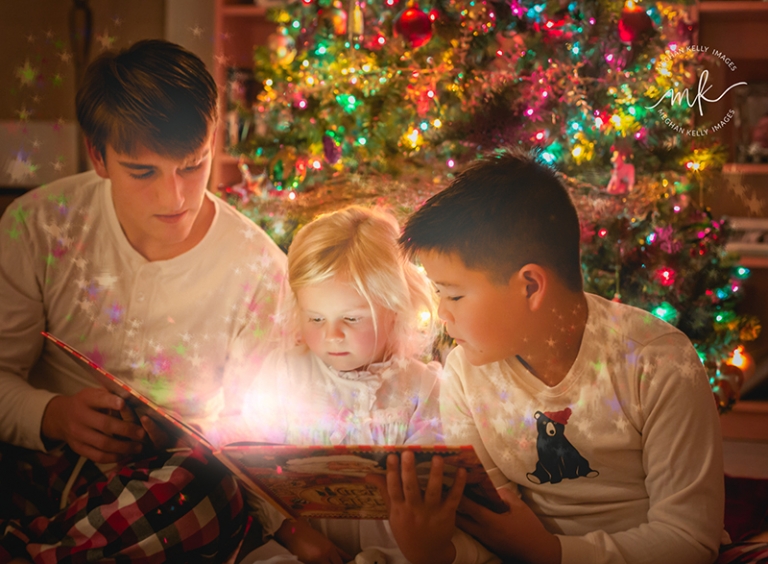
How to Create a Christmas Magic Book Photo
Every year the holiday season brings a flurry of Christmas themed child portraits to the photography community. It’s easy to see why. Christmas is a magical time for children, and as photographers, we want to capture that magic in an image that will bring parents- whether they be clients or ourselves- right back to that…
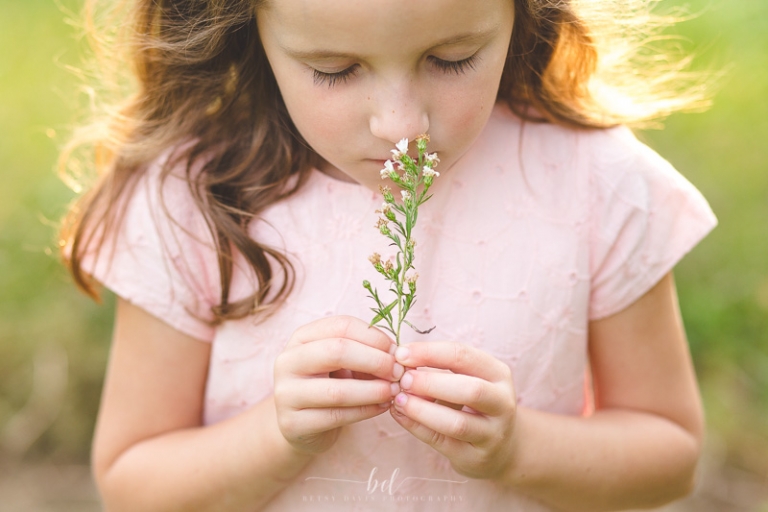
7 Simple Tips to Dramatically Improve Your Photos TODAY
If you are anything like me, you are probably always looking for ways to improve your photos… searching to find ways to take them to the next level. Sound familiar? We jump along from webinar to webinar, blog post to blog post, in search of that perfect answer to the question we find ourselves asking:…

58 Simple Ways to Quickly Improve Your Cat Photography Skills
Who doesn’t love pictures of cats? Some people say that the internet itself exists to share pics of cats, and going by how many there are, they might be right. However, cats are notoriously uncooperative, so taking a great cat picture requires more than just aiming your camera. Here are some cat photography tips to…
Student Sign In

How to Create a Photo Essay in 9 Steps (with Examples)
Photo Editing , Tutorials

This post contains affiliate links. If you use these links to buy something, we may earn a commission at no additional cost to you. We only recommend products we fully support or use ourselves. Our full disclaimer
What is a photo essay?
- Photo essays vs photo stories
- How photo essays help you
- 9 Steps to create photo essays
How to share your photo essays
Read Time: 11 minutes
Gather up a handful of images that seem to go together, and voila! It’s a photo essay, right? Well… no. Though, this is a common misconception.
In reality, a photo essay is much more thoughtful and structured than that. When you take the time to craft one, you’re using skills from all facets of our craft – from composition to curation.
In this guide, you’ll learn what makes a photo essay an amazing project that stretches your skills. You'll also learn exactly how to make one step by step.
- Photo essay vs photo story
A photo essay is a collection of images based around a theme, a topic, a creative approach, or an exploration of an idea. Photo essays balance visual variety with a cohesive style and concept.
What's the difference between a photo essay and a photo story?
The terms photo essay and photo story are often used interchangeably. Even the dictionary definition of “photo essay” includes using images to convey either a theme or a story.
But in my experience, a photo essay and a photo story are two different things. As you delve into the field of visual storytelling, distinguishing between the two helps you to take a purposeful approach to what you’re making .
The differences ultimately lie in the distinctions between theme, topic and story.
Themes are big-picture concepts. Example: Wildness
Topics are more specific than themes, but still overarching. Example : Wild bears of Yellowstone National Park
Stories are specific instances or experiences that happen within, or provide an example for, a topic or theme. Example: A certain wild bear became habituated to tourists and was relocated to maintain its wildness
Unlike a theme or topic, a story has particular elements that make it a story. They include leading characters, a setting, a narrative arc, conflict, and (usually) resolution.
With that in mind, we can distingush between a photo essay and a photo story.
Themes and Topics vs Stories
A photo essay revolves around a topic, theme, idea, or concept. It visually explores a big-picture something .
This allows a good deal of artistic leeway where a photographer can express their vision, philosophies, opinions, or artistic expression as they create their images.
A photo story is a portfolio of images that illustrate – you guessed it – a story.
Because of this, there are distinct types of images that a photo story uses that add to the understanding, insight, clarity and meaning to the story for viewers. While they can certainly be artistically crafted and visually stunning, photo stories document something happening, and rely on visual variety for capturing the full experience.
A photo essay doesn’t need to have the same level of structured variety that a photo story requires. It can have images that overlap or are similar, as they each explore various aspects of a theme.

Photo essays can be about any topic. If you live in a city, consider using your nature photography to make an essay about the wildlife that lives in your neighborhood .
The role of text with photos
A photo story typically runs alongside text that narrates the story. We're a visual species, and the images help us feel like we are there, experiencing what's happening. So, the images add significant power to the text, but they're often a partner to it.
This isn’t always the case, of course. Sometimes photo stories don’t need or use text. It’s like reading a graphic novel that doesn’t use text. Moving through the different images that build on each other ultimately unveils the narrative.
Photo essays don’t need to rely on text to illuminate the images' theme or topic. The photographer may use captions (or even a text essay), or they may let the images speak for themselves.
Definitions are helpful guidelines (not strict rules)
Some people categorize photo essays as either narrative or thematic. That's essentially just calling photo stories “narrative photo essays” and photo essays “thematic photo essays.”
But, a story is a defined thing, and any writer/editor will tell you themes and topics are not the same as stories. And we use the word “story” in our daily lives as it’s defined. So, it makes far more sense to name the difference between a photo essay and a photo story, and bask in the same clarity writers enjoy .
Photo stories illustrate a particular experience, event, narrative, something that happened or is happening.
Photo essays explore an idea, concept, topic, theme, creative approach, big-picture something .
Both photo essays and photo stories are immensely powerful visual tools. And yes, the differences between them can certainly be blurred, as is always the case with art.
Simply use this distinction as a general guideline, providing extra clarity around what you’re making and why you're making it.
To dig into specific types of images used to create powerful photo stories, check out this training: 6 Must-Have Shots for a Photo Story.
Meanwhile, let’s dig deeper into photo essays.
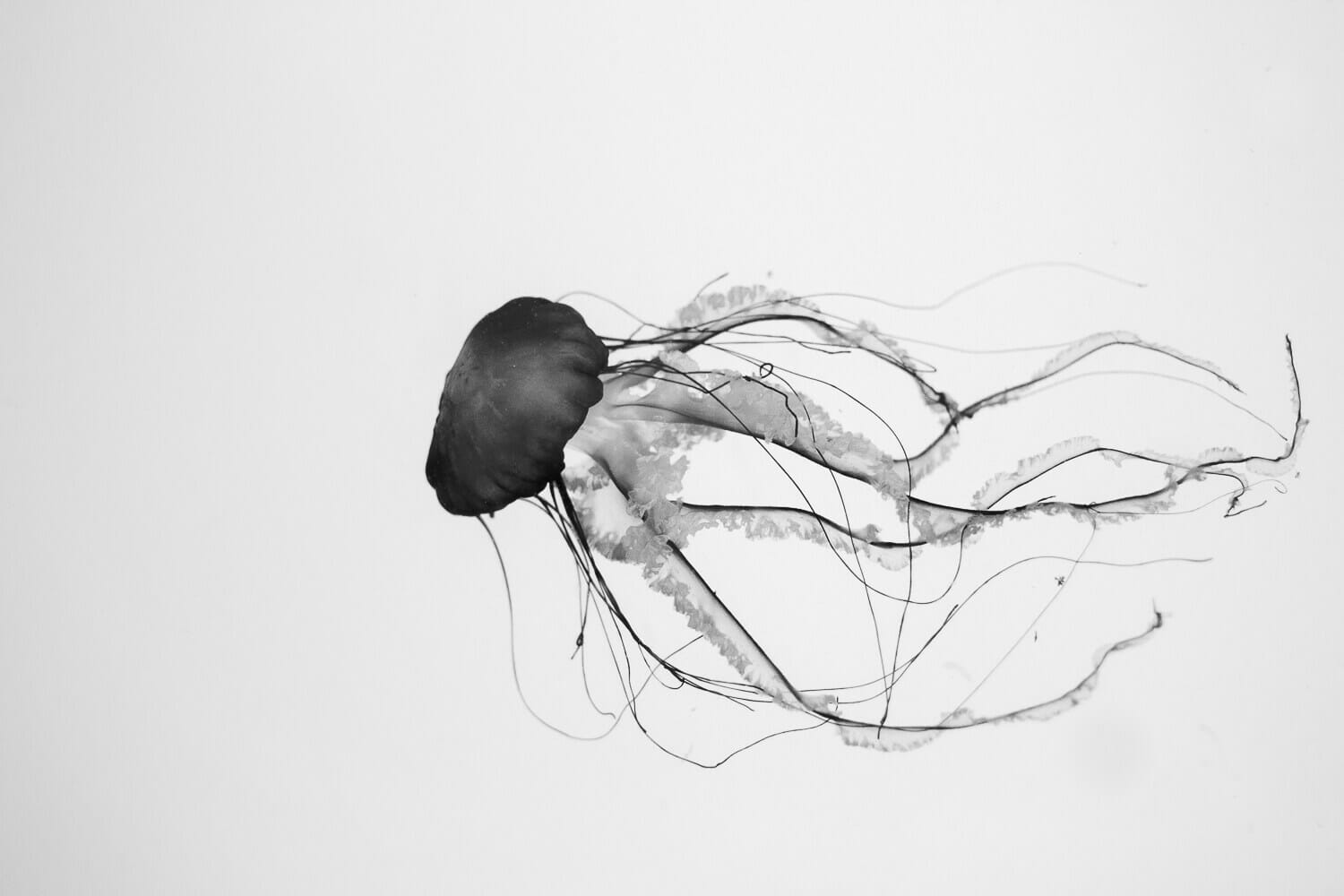
Photo essays are a chance to try new styles or techniques that stretch your skills and creativity. This image was part of an essay exploring simplicity and shape, and helped me learn new skills in black and white post-processing.
How photo essays improve your photography
Creating photo essays is an amazing antidote if you’ve ever felt a lack of direction or purpose in your photography. Photo essays help build your photographic skills in at least 3 important ways.
1. You become more strategic in creating a body of work
It's easy to get stuck in a rut of photographing whatever pops up in front of you. And when you do, you end up with a collection of stand-alone shots.
These singles may work fine as a print, a quick Instagram post, or an addition to your gallery of shots on your website. But amassing a bunch of one-off shots limits your opportunities as a photographer for everything from exhibits to getting your work published.
Building photo essays pushes you to think strategically about what you photograph, why, and how. You're working toward a particular deliverable – a cohesive visual essay – with the images you create.
This elevates your skills in crafting your photo essay, and in how you curate the rest of your work, from galleries on your website to selecting images to sell as prints .
2. You become more purposeful in your composition skills
Composition is so much more than just following the rule of thirds, golden spirals, or thinking about the angle of light in a shot.
Composition is also about thinking ahead in what you’re trying to accomplish with a photograph – from what you’re saying through it to its emotional impact on a viewer – and where it fits within a larger body of work.
Photo essays push you to think critically about each shot – from coming up with fresh compositions for familiar subjects, to devising surprising compositions to fit within a collection, to creating compositions that expand on what’s already in a photo essay.
You’re pushed beyond creating a single pleasing frame, which leads you to shoot more thoughtfully and proactively than ever.
(Here’s a podcast episode on switching from reactive shooting to proactive shooting.)
3. You develop strong editing and curation skills
Selecting which images stay, and which get left behind is one of the hardest jobs on a photographer’s to-do list. Mostly, it’s because of emotional attachment.
You might think it’s an amazing shot because you know the effort that went into capturing it. Or perhaps when you look at it, you get a twinge of the joy or exhilaration you felt the moment you captured it. There’s also the second-guessing that goes into which of two similar images is the best – which will people like more? So you’re tempted to just show both.
Ultimately, great photographers appear all the more skilled because they only show their best work. That in and of itself is a skill they’ve developed through years of ruthlessly editing their own work.
Because the most powerful photo essays only show a handful of extraordinary images, you’re bound to develop the very same critical skill (and look all the more talented because of it).
Photo essays are also a great stepping stone to creating photo stories. If you’re interested in moving beyond stand-alone shots and building stories, shooting photo essays will get your creative brain limbered up and ready for the adventure of photo stories.

A photo essay exploring the natural history of a favorite species is an exciting opportunity for an in-depth study. For me, that was a photo essay on emotive images of the American dipper (Cinclus mexicanus) as it hunts in streams.
9 Simple steps to create your photo essays
1. clarify your theme.
Choose a theme, topic, or concept you want to explore. Spend some time getting crystal clear on what you want to focus on. It helps to write out a few sentences, or even a few paragraphs noting:
- What you want the essay to be about
- What kinds of images you want to create as part of it
- How you’ll photograph the images
- The style, techniques, or gear you might use to create your images
- What “success” looks like when you’re done with your photo essay
You don’t have to stick to what you write down, of course. It can change during the image creation process. But fleshing your idea out on paper goes a long way in clarifying your photo essay theme and how you’ll go about creating it.
2. Create your images
Grab your camera and head outside!
As you’re photographing your essay, allow yourself some freedom to experiment. Try unusual compositions or techniques that are new to you.
Stretch your style a little, or “try on” the style of other photographers you admire who have photographed similar subjects.
Photo essays are wonderful opportunities to push yourself outside of your comfort zone and grow as a photographer.
Remember that a photo essay is a visually cohesive collection of images that make sense together. So, while you might stretch yourself into new terrain as you shoot, try to keep that approach, style, or strategy consistent.
Don’t be afraid to create lots of images. It’s great to have lots to choose from in the editing process, which comes up next.
3. Pull together your wide edit
Once you’ve created your images, pull together all the images that might make the cut. This could be as many as 40-60 images. Include anything you want to consider for the final essay in the wide edit.
From here, start weeding out images that:
- are weaker in composition or subject matter
- stand out like a sore thumb from the rest of the collection
- Are similar to other stronger images in the collection
It's helpful to review the images at thumbnail size. You make more instinctive decisions and can more easily see the body of work as a whole. If an image is strong even at thumbnail size to stand out from similar frames while also partnering well with other images in the collection, that's a good sign it's strong enough for the essay.
4. Post-process your images for a cohesive look
Now it’s time to post-process the images. Use whatever editing software you’re comfortable with to polish your images.
Again, a photo essay has a cohesive visual look. If you use presets, filters, or other tools, use them across all the images.
5. Finalize your selection
It’s time to make the tough decisions. Select only the strongest for your photo essay from your group of images.
Each image should be strong enough to stand on its own and make sense as part of the whole group.
Many photo essays range from 8-12 images. But of course, it varies based on the essay. The number of images you have in your final photo essay is up to you.
Remember, less is more. A photo essay is most powerful when each image deserves to be included.
6. Put your images in a purposeful order
Create a visual flow with your images. Decide which image is first, and build from there. Use compositions, colors, and subject matter to decide which image goes next, then next, then next in the order.
Think of it like music: notes are arranged in a way that builds energy, or slows it down, surprise listeners with a new refrain, or drop into a familiar chorus. How the notes are ordered creates emotional arcs for listeners.
How you order your images is similar.
Think of the experience a viewer will have as they look at one image, then the next, and the next. Order your images so they create the experience you want your audience to have.
7. Get feedback
The best photographers make space for feedback, even when it’s tough to hear. Your work benefits from not just hearing feedback, but listening to it and applying what you learn from it.
Show your photo essay to people who have different sensibilities or tastes. Friends, family members, fellow photographers – anyone you trust to give you honest feedback.
Watch their reactions and hear what they say about what they’re seeing. Use their feedback to guide you in the next step.
8. Refine, revise, and finalize
Let your photo essay marinate for a little while. Take a day or two away from it. Then use your freshened eyes and the feedback you received from the previous step to refine your essay.
Swap out any selects you might want to change and reorder the images if needed.
9. Add captions
Even if you don’t plan on displaying captions with your images, captioning your images is a great practice to get into. It gives context, story, and important information to each image. And, more than likely, you will want to use these captions at some point when you share your photo essay, which we dive into later in this article.
Add captions to the image files using Lightroom, Bridge, or other software programs.
Create a document, such as a Google or Word doc, with captions for each image.
In your captions, share a bit about the story behind the image, or the creation process. Add whatever makes sense to share that provides a greater understanding of the image and its purpose.
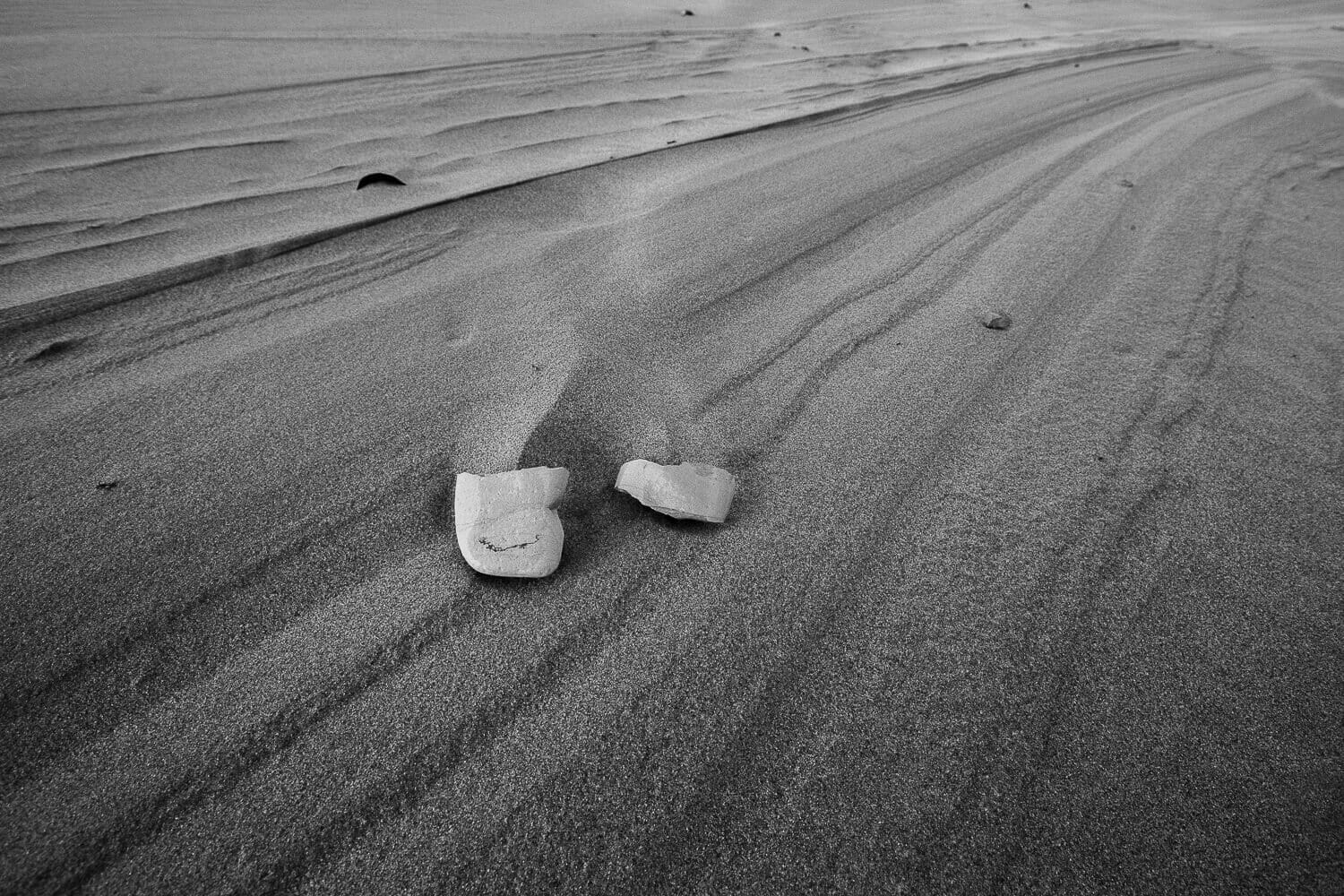
Photo essays allow you to explore deliberate style choices, such as a focus on shapes, patterns, textures, and lines. Since each photo is part of a larger essay, it encourages you to be bold with choices you might not otherwise make.
5 Examples of amazing nature photo essays
1. “how the water shapes us” from the nature conservancy.
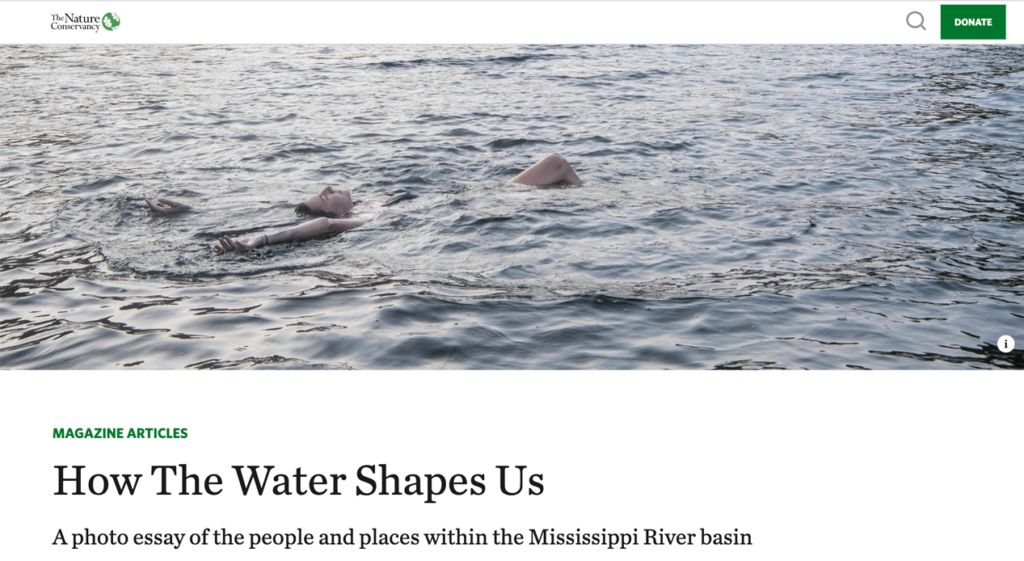
This gorgeous essay, crafted with the work of multiple photographers, explores the people and places within the Mississippi River basin. Through the images, we gain a sense of how the water influences life from the headwater all the way to the Gulf of Mexico. Notice how each photographer is tasked with the same theme, yet approaches it with their own distinct style and vision. It is a wonderful example of the sheer level of visual variety you can have while maintaining a consistent style or theme.
View it here
2. “A Cyclist on the English Landscape” from New York Times’ The World Through A Lens series

This photo essay is a series of self-portraits by travel photographer Roff Smith while “stuck” at home during the pandemic. As he peddled the roads making portraits, the project evolved into a “celebration of traveling at home”. It’s a great example of how visually consistent you can be inside a theme while making each image completely unique.
3. “Vermont, Dressed In Snow” from New York Times’ The World Through A Lens series

This essay by aerial photographer Caleb Kenna uses a very common photo essay theme: snow. Because all images are aerial photographs, there’s a consistency to them. Yet, the compositions are utterly unique from one another. It’s a great example of keeping viewers surprised as they move from one image to the next while still maintaining a clear focus on the theme.
4. “Starling-Studded Skies” from bioGraphic Magazine
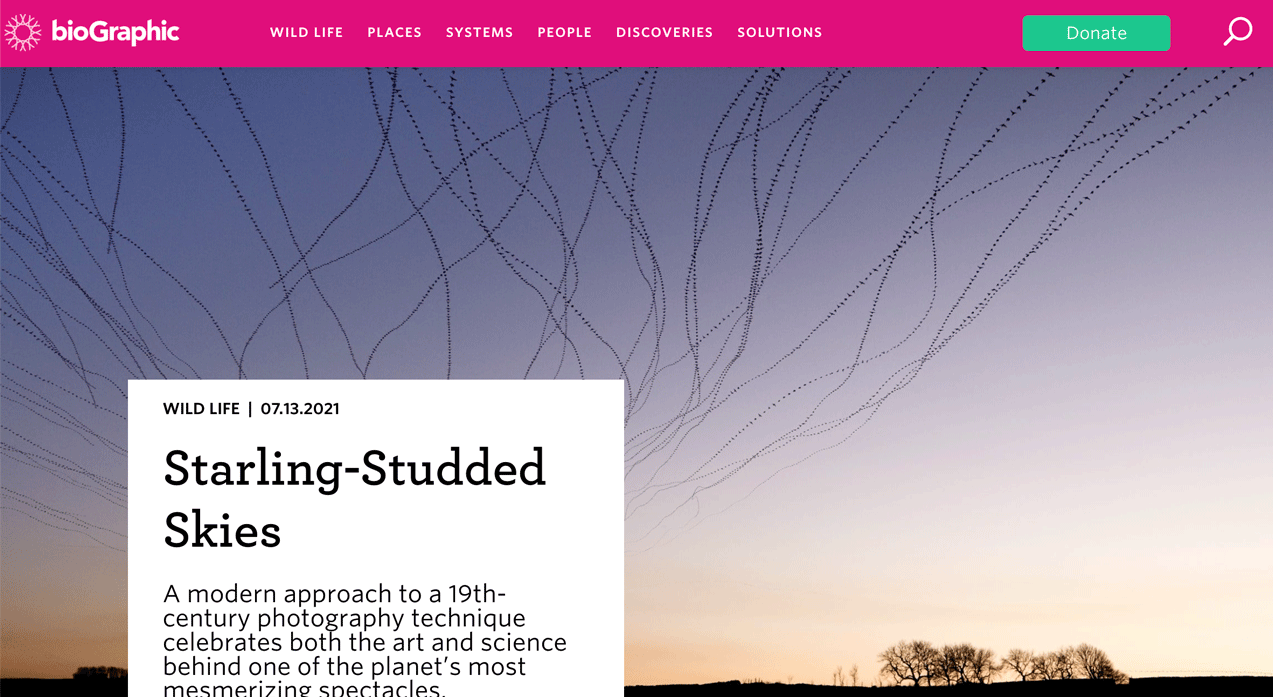
This beautiful essay is by Kathryn Cooper, a physicist trained in bioinformatics, and a talented photographer. She used a 19th century photographic technique, chronophotography, to create images that give us a look at the art and science of starling murmurations. She states: “I’m interested in the transient moments when chaos briefly changes to order, and thousands of individual bodies appear to move as one.” This essay is a great example of deep exploration of a concept using a specific photographic technique.
View it here (Note: must be viewed on desktop)
5. “These Scrappy Photos Capture the Action-Packed World Beneath a Bird Feeder” from Audubon Magazine
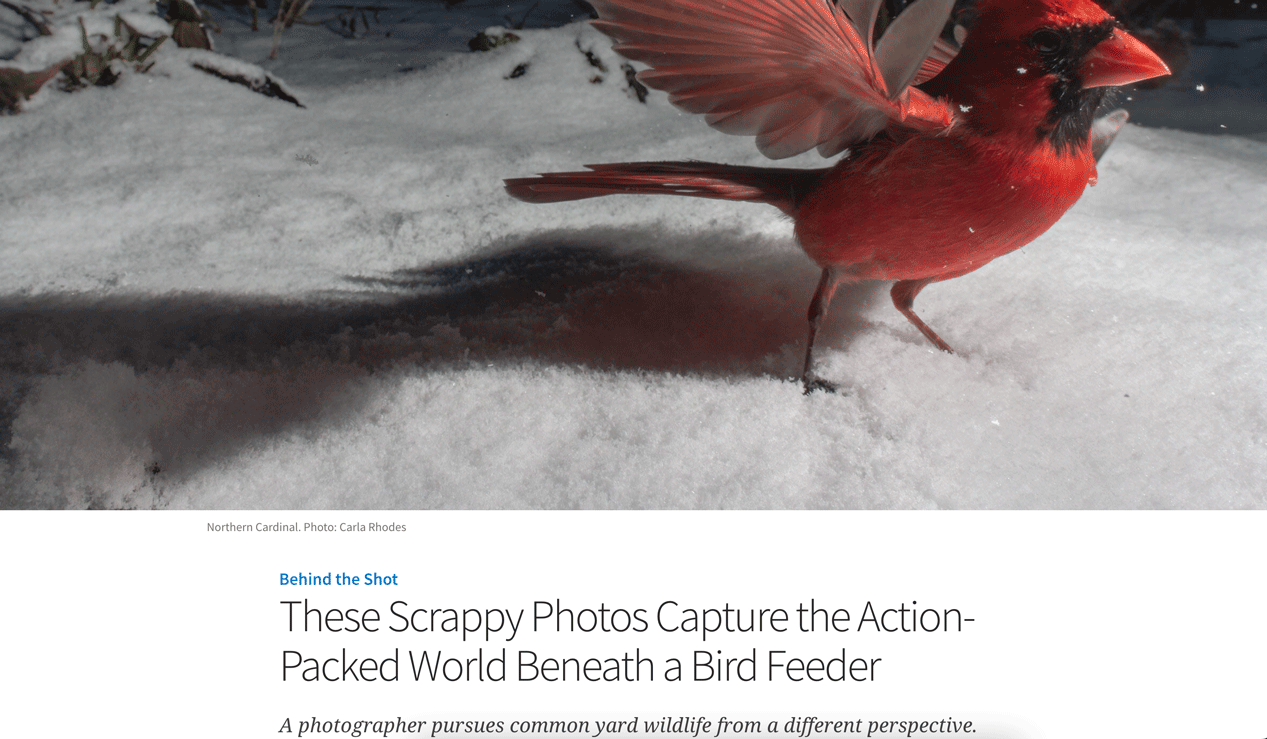
This photo essay from conservation photographer Carla Rhodes explores the wildlife that takes advantage of the bounty of food waiting under bird feeders . Using remote camera photography , Rhodes gives viewers a unique ground-level perspective and captures moments that make us feel like we’re in conversation with friends in the Hundred Acre Woods. This essay is a great example of how perspective, personality, and chance can all come into play as you explore both an idea and a technique.
25 Ideas for creative photo essays you can make
The possibilities for photo essays are truly endless – from the concepts you explore to the techniques you use and styles you apply.
Choose an idea, hone your unique perspective on it, then start applying the 9 simple steps from above.
- The life of a plant or animal (your favorite species, a species living in your yard, etc)
- The many shapes of a single species (a tree species, a bird species, etc)
- How a place changes over time
- The various moods of a place
- A conservation issue you care about
- Math in nature
- Urban nature
- Seasonal changes
- Your yard as a space for nature
- Shifting climate and its impacts
- Human impacts on environments
- Elements: Water, wind, fire, earth
- Day in the life (of a person, a place, a stream, a tree…)
- Outdoor recreation (birding, kayaking, hiking, naturalist journaling…)
- Wildlife rehabilitation
- Lunar cycles
- Sunlight and shadows
- Your local watershed
- Coexistence

As you zero in on a photo essay theme, consider two things: what most excites you about an idea, and what about it pushes you out of your comfort zone. The heady mix of joy and challenge will ensure you stick with it.
Your photo essay is ready for the world! Decide how you’d like to make an impact with your work. You might use one or several of the options below.
1. Share it on your website
Create a gallery or a scrollytelling page on your website. This is a great way to drive traffic to your website where people can peruse your photo essay and the rest of the photography you have.
Putting it on your website and optimizing your images for SEO helps you build organic traffic and potentially be discovered by a broader audience, including photo editors.
2. Create a scrollytelling web page
If you enjoy the experience of immersive visual experiences, consider making one using your essay. And no, you don’t have to be a whiz at code to make it happen.
Shorthand helps you build web pages with scrollytelling techniques that make a big impression on viewers. Their free plan allows you to publish 3 essays or stories.
3. Create a Medium post
If you don’t have a website and want to keep things simple, a post on Medium is a great option.
Though it’s known for being a platform for bloggers, it’s also possible to add images to a post for a simple scroll.
And, because readers can discover and share posts, it’s a good place for your photos to get the attention of people who might not otherwise come across it.
4. Share it on Instagram
Instagram has changed a lot over the last couple of years, but it’s still a place for photographers to share their work thoughtfully.
There are at least 3 great ways to share your photo essay on the platform.
– Create a single post for each image. Add a caption. Publish one post per day until the full essay is on your feed. Share each post via Instagram Stories to bring more attention and interaction to your photo essay.
– Create a carousel post. You can add up 10 photos to a carousel post, so you may need to create two of them for your full photo essay. Or you might create a series of carousel posts using 3-4 images in each.
– Create a Reel featuring your images as a video. The algorithm heavily favors reels, so turning your photo essay into a video experience can get it out to a larger audience.
I ran a “create a reel” challenge in my membership community. One member created a reel with her still images around a serious conservation issue. It gathered a ton of attention and landed her opportunities to share her message through YouTube and podcast interviews and publishing opportunities. Watch it here.
5. Exhibit it locally
Reach out to local galleries, cafes, pubs, or even the public library to see if they’re interested in hanging your photo essay for display. Many local businesses and organizations happily support the work of local artists.
6. Pitch your photo essay to publications
One of the best ways to reach an audience with your work is to get it published. Find publications that are a great fit for the theme and style of your photo essay, then pitch your essay for consideration. You gain a fantastic opportunity to share your work widely and can earn a paycheck at the same time.
Remember that if you want to get your photo essay published, you may want to hold back from sharing it publicly before you pitch it to publications.
PIN THIS FOR LATER
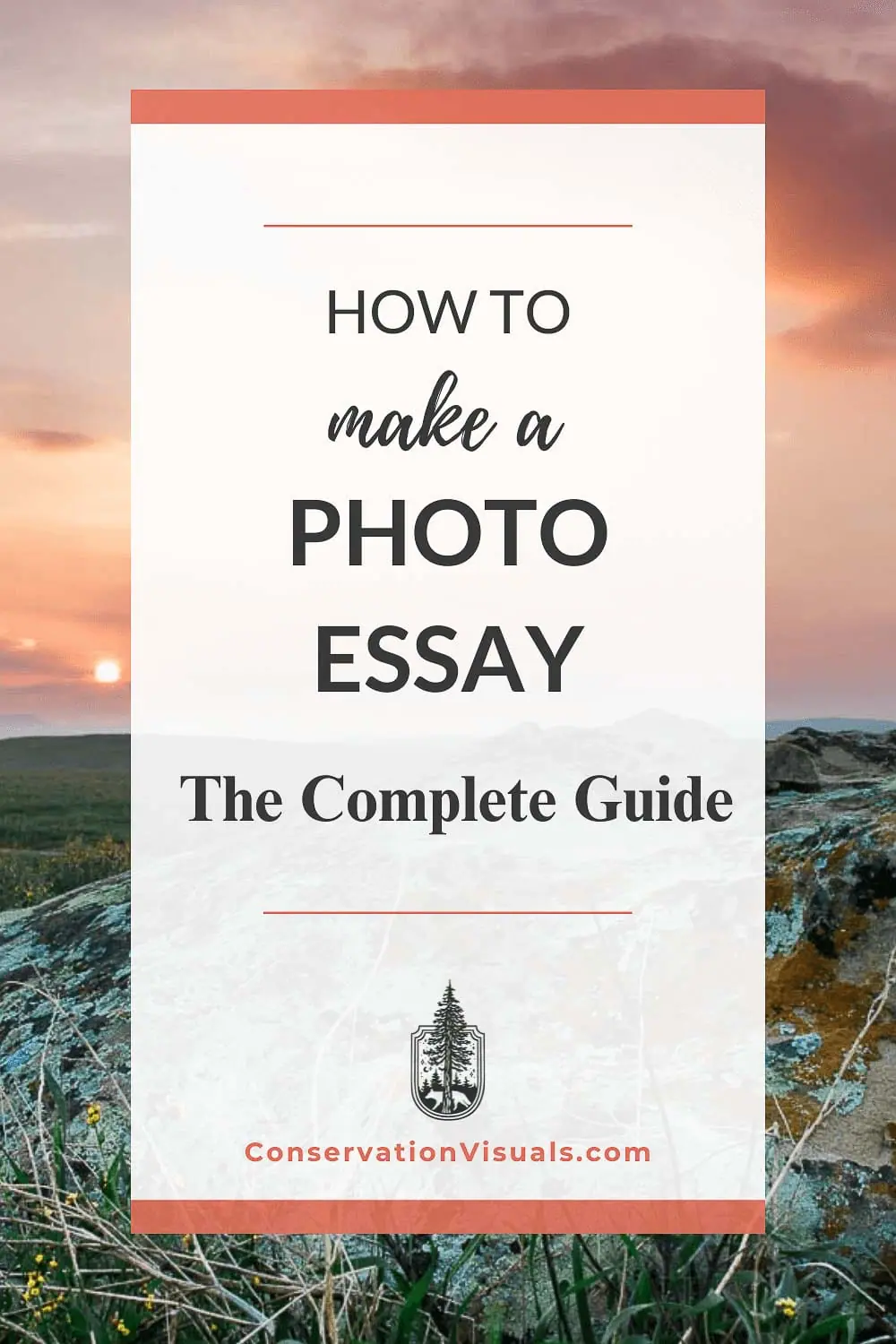
What’s your hidden storyteller personality as a nature photographer?
Take my FREE quiz to discover your storyteller super-strengths AND get a custom action plan based on your results

Jaymi Heimbuch
Next up….

Portrait vs. Landscape Orientation: The Biggest Differences to Know
Discover the impact of portrait & landscape orientation on your photography. Learn the key differences and how to choose the right orientation for your subject.

7 Best Ways to Sell Nature Photos Online (2024)
Photography Business , Tutorials
Discover the top 7 strategies for selling your stunning nature photos online. Learn how to sell your photos and reach a wider audience.

Camera Lens Hoods: When & How to Use Them for Better Photos
Photo Accessories , Gear , How to Use Photo Gear
Get better photos with camera lens hoods. Learn what it is, when to use it (or ditch it), and why it’s essential for nature photographers.
WHAT DO YOU WANT TO READ TODAY?
POPULAR SEARCHES: Best Cameras | Location Guide | Best Lenses | Wildlife
Take The Quiz
Get super clear on exactly what to focus on right now to grow your photography skills fast..
Take the FREE Full Frame Ecosystem Assessment ™ to crack the code on your roadblocks so you can hop into the creativity express lane with personalized action steps!
Ready to level up your awesome?
Start your next learning adventure.

52 Week Creativity Kit
A year of weekly bite-sized nature photography concepts and challenges that strengthen your camera skills and provide endless inspiration.

6 Must-Have Shots for a Photo Story
New to photo stories? Start by learning how to create a powerful photo story with the 6 essential images that all photo editors want to publish.

Photo Stories for Nature
Master how to photograph impressive photo stories and effectively share them so they make an impact.

Conservation Filmmaking 101
Master how to craft powerfully moving films that create conservation impact.
Get The Most Popular Free Resources
Make leaps forward in your visual storytelling download three of our most valuable free resources for photographers..

Ready to take better photos?
Get all the good things delivered.
Photography how-to guides, expert interviews, behind-the-scenes insights & more all delivered to your inbox weekly.
Privacy Overview
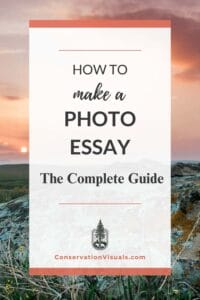
- Join for Free
Narrative Photo Essays with Models and Sets
A course by samuka marinho , photographer, illustrator, and editor.
Learn to use lighting, props, and characters in your photoshoots to tell inspiring stories with your camera
- Portuguese with subtitles in English
- 100% positive reviews ( 7 )
- 196 students
- Information

It's been said time and again that an image is worth a thousand words. So can you imagine the visual impact of a project that compiles a series of them? Samuka Marinho is an illustrator, photographer, photo editor, and the creator of Corsários , a 192-page photographic narrative that tells the story of the so-called Golden Age of Piracy with more than 400 richly crafted scenes.
In this online course, learn to develop a visual narrative alongside Samuka, who walks you through the entire process involved in creating a photo essay that tells a powerful story, from the initial idea to the final editing in Adobe Photoshop. Combine images and words to depict original and captivating stories!
What will you learn in this online course?
14 lessons & 21 downloads

- 14 lessons (1h 25m)
- 21 additional resources (9 files)
- Online and at your own pace
- Available on the app
- Audio: Portuguese
- Portuguese , Spanish , English , German , French , Italian , Polish , Dutch
- Level: Beginner
- Unlimited access forever
Recommended software for this course
What is this course's project?
Create your own narrative photo essay or photo novel.

Who is this online course for?
Photographers, visual artists, and anyone interested in venturing out into the world of narrative photography.
Requirements and materials
Basic knowledge of photography is recommended for this course.
As for materials, you need a DSLR camera capable of shooting in RAW mode, two or more flash devices, light modifiers, a tripod, colored cellophane sheets, and a computer with Adobe Photoshop installed.

Excellent et très inspirant. Merci.
View translation
Hide translation
Very knowledgeable and inspiring presenter. I have found many new artists to study and take inspiration from after watching this course. Enjoyable and well paced course. This is already helping me to improve my personal projects.
cuatrodemas
Excelente curso
eversongermano
Malenkasher.
muy buen curso, varios tips
- More reviews

Samuka Marinho A course by Samuka Marinho
Samuka Marinho is an illustrator, photographer, and photo editor whose work has been featured on book and album covers, exhibited in galleries, and included in specialized publications. He has also collaborated on advertising campaigns awarded with the Cannes Gold Lion. But his most ambitious project to date is Corsários , a 192-page photographic narrative depicting the so-called Golden Age of Piracy in over 400 carefully crafted scenes.
Introduction
Pre-production.
- Project "Corsairs"
- From text to image
- Taking off paper
- Studio and equipment
- Studio and lighting map
- Shoot scene objects
Post production
- Layout assembly
- Image editing
- Finalization of the image
Final project
What to expect from a domestika course, learn at your own pace.
Enjoy learning from home without a set schedule and with an easy-to-follow method. You set your own pace.
Learn from the best professionals
Learn valuable methods and techniques explained by top experts in the creative sector.
Meet expert teachers
Each expert teaches what they do best, with clear guidelines, true passion, and professional insight in every lesson.
Certificates Plus
If you're a Plus member, get a custom certificate signed by your teacher for every course. Share it on your portfolio, social media, or wherever you like.
Get front-row seats
Videos of the highest quality, so you don't miss a single detail. With unlimited access, you can watch them as many times as you need to perfect your technique.
Share knowledge and ideas
Ask questions, request feedback, or offer solutions. Share your learning experience with other students in the community who are as passionate about creativity as you are.
Connect with a global creative community
The community is home to millions of people from around the world who are curious and passionate about exploring and expressing their creativity.
Watch professionally produced courses
Domestika curates its teacher roster and produces every course in-house to ensure a high-quality online learning experience.
Domestika's courses are online classes that provide you with the tools and skills you need to complete a specific project. Every step of the project combines video lessons with complementary instructional material, so you can learn by doing. Domestika's courses also allow you to share your own projects with the teacher and with other students, creating a dynamic course community.
All courses are 100% online, so once they're published, courses start and finish whenever you want. You set the pace of the class. You can go back to review what interests you most and skip what you already know, ask questions, answer questions, share your projects, and more.
The courses are divided into different units. Each one includes lessons, informational text, tasks, and practice exercises to help you carry out your project step by step, with additional complementary resources and downloads. You'll also have access to an exclusive forum where you can interact with the teacher and with other students, as well as share your work and your course project, creating a community around the course.
You can redeem the course you received by accessing the redeeming page and entering your gift code.
- Photography & Video
- Communication
- Digital Photography
- Fine-Art Photography
- Photo Retouching
- Photography Post-production
- Storytelling
Courses you might be interested in

Narrative Photography – Storytelling Through the Lens
Narrative photography is a captivating genre that transcends mere visual documentation, delving into the realm of storytelling through images. Unlike traditional photography that focuses solely on aesthetics or technical prowess, narrative photography weaves a compelling narrative, evoking emotions, raising questions, and inviting viewers into a richly layered visual narrative. Through carefully composed scenes, use of symbolism, and strategic framing, narrative photographers craft stories that resonate deeply with their audience, sparking imagination and fostering a profound connection between the viewer and the captured moment.
Table of Contents
- 1 Key Takeaways
- 2 What Is Narrative Photography?
- 3.1 Understanding Narrative Photography
- 3.2 Elements of Composition
- 3.3 Influence of Light and Color
- 4.1 Strategic Camera Settings
- 4.2 Choosing the Right Equipment
- 5.1 Crafting a Visual Language
- 5.2 Capturing Emotion and Authenticity
- 5.3 Photo Essays
- 5.4 Photographs as Clues
- 5.5 Sequencing and the Narrative Structure
- 6.1 Styles and Approaches
- 6.2 From Single Images to Photo Essays
- 7.1 How Does Narrative Photography Differ from Other Photography Genres?
- 7.2 Who Are Some Prominent Artists in the Field of Narrative Photography?
- 7.3 How Can Photographers Effectively Use Sequence and Timing in Narrative Photography?
Key Takeaways
- Narrative photography is a method of using images to tell a story, emphasizing a connected sequence of events.
- Effective narrative photography employs composition, lighting, and perspective to convey the story and engage the viewer.
- Narrative photographers craft visual stories that resonate emotionally and contextually with their audience.
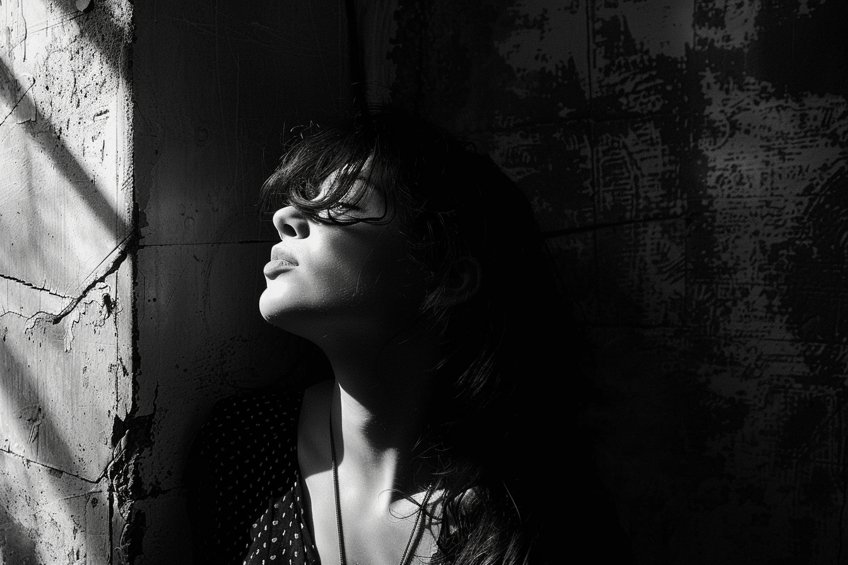
What Is Narrative Photography?
Narrative photography is a genre that transcends mere image capturing to embrace the art of storytelling. Through this visual medium, photographers chronicle events, emotions, and contexts, weaving together a series of images that collectively tell a compelling story. Unlike traditional photography focused on individual moments or aesthetic appeal, narrative photography aims to impart a storyline that is coherent, dynamic, and evocative. This style is prevalent in various mediums, from newspapers to fine art galleries, demonstrating its significance in visual storytelling.
Key elements such as composition, perspective, and lighting are not just tools for visual appeal but are carefully considered choices that contribute to the unfolding narrative.
Photographers utilizing this genre often seek to connect with their audience on a deeper level, inviting them to engage with the imagery and piece together the underlying story. The myriad of techniques available allows the photographer to guide viewers through the narrative, shaping their experience and interpretation of the visual tale being told.

Unlike random snapshots, narrative photography requires intentional decisions about what elements to include and omit. Key components often featured in narrative photography are:
- Context: The setting or environment where the story takes place.
- Characters: Individuals or subjects that play a role in the narrative.
- Action: Events or interactions displayed within the photograph.
- Emotions: Conveyed through facial expressions, body language, or the overall mood.
Photographers employ these elements to guide the viewer through a visual journey. The power of narrative photography lies in its ability to construct a narrative without words, often provoking thought and sparking imagination.
It is not constrained by factual representation but can also explore fictional tales, thereby expanding its creative boundaries.
In practice, the photographer assumes the role of a storyteller. The sequence and structure of the images are crucial as they enable the photographer to build a coherent and engaging story. Effective narrative photography can capture the viewer’s attention and communicate complex ideas through the lens of the camera.
Foundations of Narrative Photography
Narrative photography goes beyond capturing a moment; it’s about conveying a story through visual elements within a photograph. It requires attention to composition, the strategic use of light and color, and the incorporation of emotion and context to create a compelling picture that narrates a tale.
Understanding Narrative Photography
In narrative photography, each image serves as a chapter in a story. The photographer’s task is to distill a narrative into a single frame, or a series of images, that holds the viewer’s attention. Key attributes of narrative photography include the ability to evoke emotion and provide context, immersing the viewer fully into the scene.

Elements of Composition
An effective narrative photograph relies on an array of compositional elements. Strong composition is characterized by:
- Subject: The main focus of the story being told.
- Background: Supports the subject by adding depth and context.
- Visual elements: Lines, shapes, and space that guide the viewer’s eye through the story.
Influence of Light and Color
Light and color are powerful tools in shaping the mood and enhancing the story in a photograph. They can be manipulated to:
- Highlight emotion: Different lighting can evoke different feelings, like warmth or tension.
- Set context: Color can signify time of day or season, placing the narrative within a specific frame of reference.
By understanding and employing these foundational elements, a photographer crafts images into stories that resonate with viewers on an emotional level.


Techniques and Tools
Narrative photography relies on a photographer’s ability to use camera settings and equipment strategically to convey a story. Knowing how to manipulate these aspects helps in enhancing the visual storytelling power of the images.
Strategic Camera Settings
The photographer has to master various camera settings to control how the story is represented. Exposure settings are foundational in narrative photography, as they dictate the mood and tone of the image. They can choose a shallow depth of field to isolate subjects, often achieved through wide aperture settings, which draws the viewer’s focus to specific narrative elements.
- Rule of thirds: A composition guideline that suggests dividing the image into thirds, both horizontally and vertically, and placing the main subject along these lines or their intersections.
- Exposure triangle: The combination of aperture, shutter speed, and ISO. These settings must be balanced to achieve the desired effect, whether it’s to freeze a moment in time or create a sense of motion.
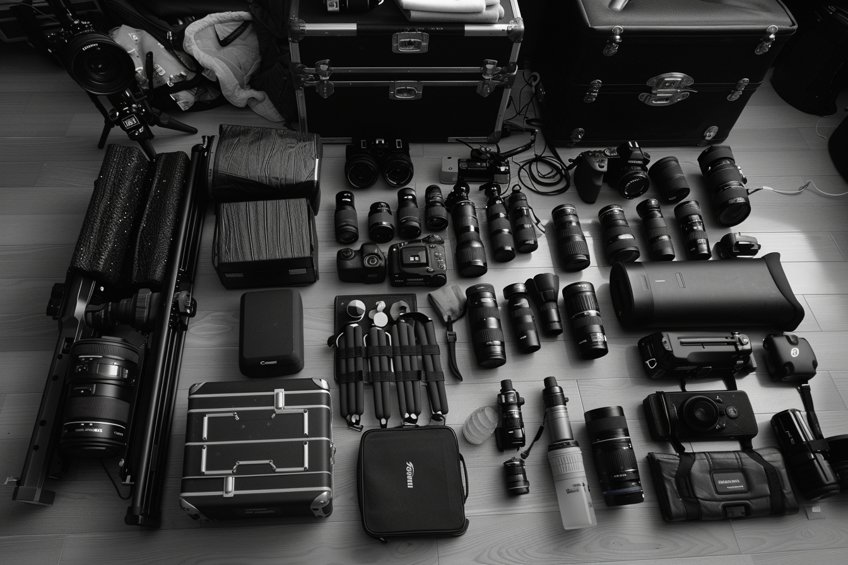
Choosing the Right Equipment
The equipment a photographer chooses directly affects the narrative ability of their photographs. Lens choice is particularly crucial, with different focal lengths telling different stories. A telephoto lens may be employed to compress a scene and bring distant subjects closer, often creating a more intimate and focused narrative.
- Focal length: Short focal lengths (wide-angle lenses) can capture a broad scene and provide context, while longer focal lengths (telephoto lenses) can focus on details and compress perspective.
- Lens type: Certain lenses, such as prime lenses, offer sharpness and a wide aperture for a shallow depth of field, indispensable for making subjects stand out.
It’s essential for the photographer to understand the capabilities and limitations of their gear to fully exploit the power of narrative photography.
Building a Narrative
Narrative photography weaves a story using visual elements and composition, aiming to evoke emotion while maintaining authenticity. Photographers must create a compelling narrative through a carefully selected series of images, utilizing a well-considered narrative structure.
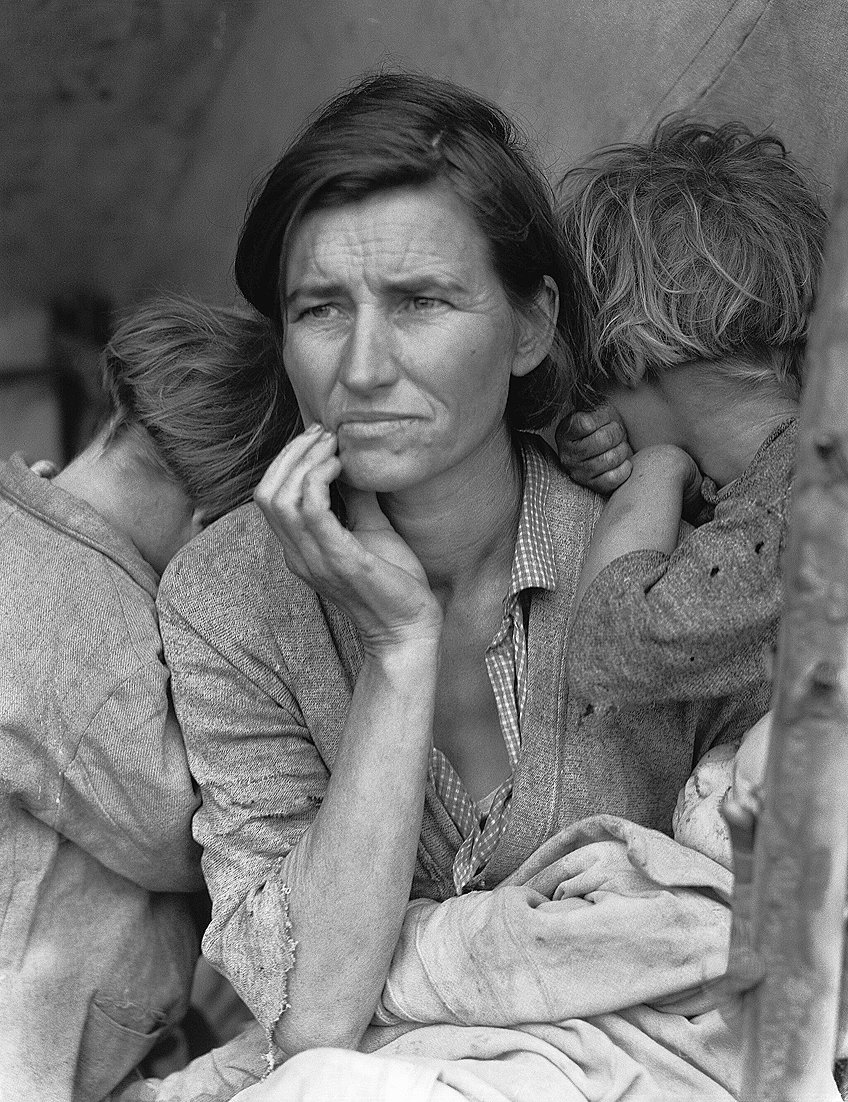
Crafting a Visual Language
In narrative photography, the visual language is the alphabet of storytelling. It is characterized by the use of composition, light, and color to convey the themes and emotions of the story. A consistent visual style ensures that each image speaks the same dialect, reinforcing the narrative’s overall impact.
Photographers might use recurring elements or symbolism to establish a coherent visual language.
Capturing Emotion and Authenticity
The emotional core of a narrative is central to its authenticity. Photographers capture candid moments that reflect genuine feelings, which resonate with viewers and lend credibility to the storytelling aspect. Shots filled with emotion often serve as the anchors of a story, around which other images are strategically placed.

Photo Essays
A photo essay is an excellent format for a chronological narrative, showcasing a series of images that build upon each other to tell a complete story. They often start with a wide establishing shot and progress through medium and close-up photos, showing various perspectives and details, much like chapters in a book.
Photographs as Clues
Each photograph in a narrative series can act as a clue to the larger story. The photographer carefully selects images that hint at aspects of the narrative without revealing everything at once, compelling the viewer to move to the next image for more pieces of the story. This technique requires a meticulous selection process to ensure that each image contributes meaningfully to the narrative.
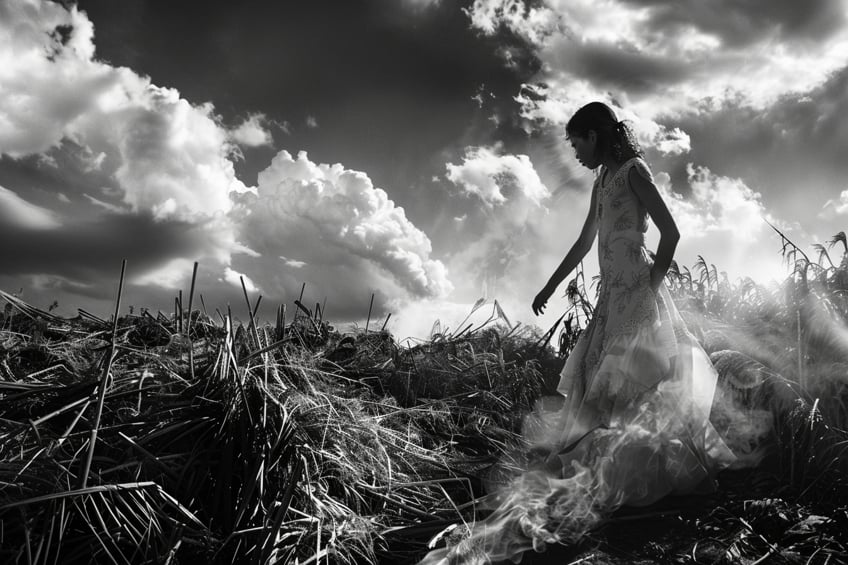
Sequencing and the Narrative Structure
The sequence in which images are presented is the backbone of the narrative structure. The order needs to create a rhythm that guides the viewer seamlessly from one photograph to the next. A skillfully sequenced narrative might follow a linear timeline.
Alternatively, it could be more abstract, requiring the viewer to piece together the narrative from the emotional and thematic depth of the images.
Narrative Photography in Practice
Narrative photography harnesses the power of visual storytelling, utilising various styles and approaches to convey a story or emotion within a frame. Photographers leverage techniques to craft a narrative that can unfold across a single image or be elaborated through a series such as photo essays.
Styles and Approaches
In narrative photography, styles can range from documentary and candid to posed and abstract. Each style lends itself to different storytelling techniques:
- Documentary: Photographers capture events as they happen with a focus on honest representations of reality.
- Candid: Unexpected moments are frozen in time, often revealing genuine emotions or actions.
- Posed: Deliberate compositions create a narrative with subjects aware of the camera’s presence.
- Abstract: More elusive, this approach uses shapes, colors, and forms to imply a story, leaving interpretation up to the viewer.
Examples of narrative photography might include a series of portraits that share the life story of an individual, or photojournalists communicating the essence of an event that bears historical significance.
From Single Images to Photo Essays
The narrative potential varies significantly between a single image and a photo essay. A single photograph must encapsulate its narrative succinctly, a challenge that often requires a careful juxtaposition of elements within the frame. These elements can include:
- Composition: Drawing the viewer’s eye along a visual path.
- Lighting: Highlighting subjects or setting a mood.
- Expressions: Conveying emotion through subjects’ faces or body language.
Conversely, photo essays permit an in-depth exploration of a subject, allowing photographers to construct a more comprehensive narrative. This can be broken down into specific components:
- Introduction: Sets the context and introduces the main subject.
- Conflict: Often highlights a challenge or a pivotal point in the narrative.
- Resolution: Concludes the story with a resolution or a call to reflective thought.
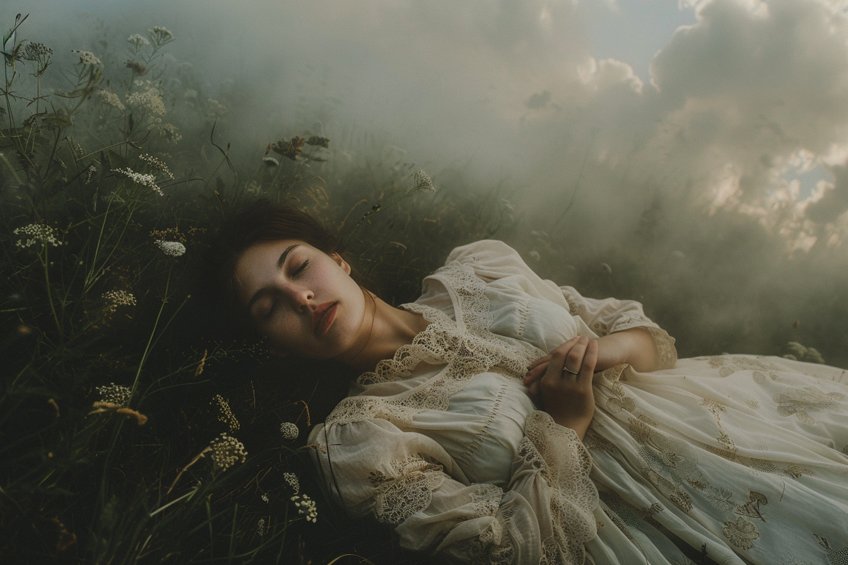
Narrative photography stands as a testament to the power of visual storytelling, bridging the gap between imagination and reality through carefully curated images. By harnessing the elements of composition, symbolism, and storytelling techniques, narrative photographers create captivating narratives that transcend the boundaries of language and culture, speaking directly to the universal human experience. As viewers engage with these narratives, they not only witness moments frozen in time but also embark on a journey of exploration, interpretation, and emotional connection, making narrative photography a timeless and impactful art form that continues to inspire and provoke thought.
Frequently Asked Questions
How does narrative photography differ from other photography genres.
Narrative photography is characterized by its emphasis on storytelling, contrasting with genres that might prioritize aesthetics or technical prowess. It seeks to convey a message or a sequence of events through visually linked images, providing a sense of progression or narrative to the viewer.
Who Are Some Prominent Artists in the Field of Narrative Photography?
Prominent figures in narrative photography include Henri Cartier-Bresson, known for his concept of the decisive moment, and W. Eugene Smith, whose photo essays exemplify compelling storytelling. These photographers have made significant contributions to the art form by integrating strong narrative elements into their work.
How Can Photographers Effectively Use Sequence and Timing in Narrative Photography?
In narrative photography, sequence and timing are critical for establishing a sense of flow and development in the story. Photographers often use these elements to build tension or determine pacing, arranging images in a particular order that guides the viewer through the narrative.

Isabella studied at the University of Cape Town in South Africa and graduated with a Bachelor of Arts majoring in English Literature & Language and Psychology. Throughout her undergraduate years, she took Art History as an additional subject and absolutely loved it. Building on from her art history knowledge that began in high school, art has always been a particular area of fascination for her. From learning about artworks previously unknown to her, or sharpening her existing understanding of specific works, the ability to continue learning within this interesting sphere excites her greatly.
Her focal points of interest in art history encompass profiling specific artists and art movements, as it is these areas where she is able to really dig deep into the rich narrative of the art world. Additionally, she particularly enjoys exploring the different artistic styles of the 20 th century, as well as the important impact that female artists have had on the development of art history.
Learn more about Isabella Meyer and the Art in Context Team .
Cite this Article
Isabella, Meyer, “Narrative Photography – Storytelling Through the Lens.” Art in Context. March 20, 2024. URL: https://artincontext.org/narrative-photography/
Meyer, I. (2024, 20 March). Narrative Photography – Storytelling Through the Lens. Art in Context. https://artincontext.org/narrative-photography/
Meyer, Isabella. “Narrative Photography – Storytelling Through the Lens.” Art in Context , March 20, 2024. https://artincontext.org/narrative-photography/ .
Similar Posts
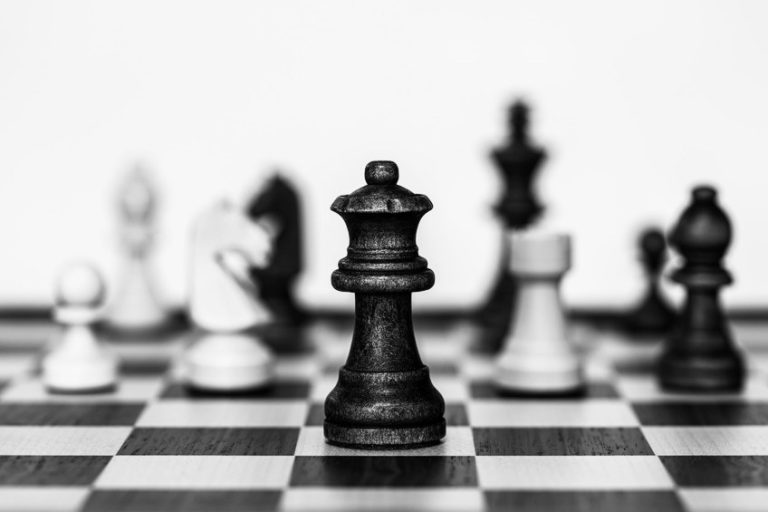
Types of Photography – Examining Different Photography Styles

Types of Portrait Photography – Unique Portrait Styles
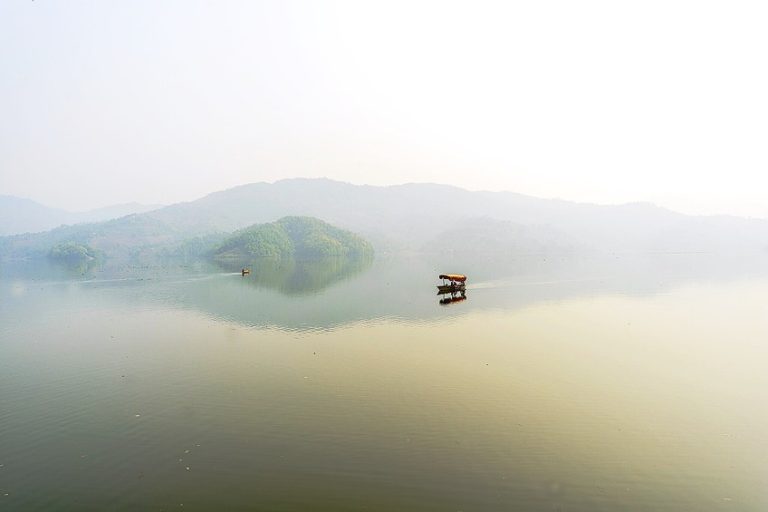
Minimalist Photography – The Power of Simplicity

Architectural Photography – What Is Architecture Photography?

Street Photography – Capturing Life in the City
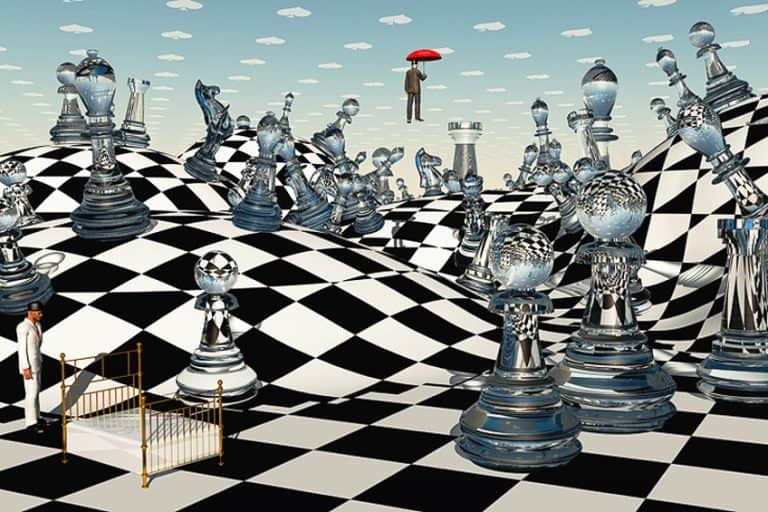
Conceptual Photography – The Story Behind the Shot
Leave a reply cancel reply.
Your email address will not be published. Required fields are marked *
Save my name, email, and website in this browser for the next time I comment.
The leading authority in photography and camera gear.
Become a better photographer.
12.9 Million
Annual Readers
Newsletter Subscribers
Featured Photographers
Photography Guides & Gear Reviews

Narrative Photography (Ideas, Examples and Techniques)
Dive into narrative photography: a visual storytelling art. Explore inspiring ideas, striking examples, and master techniques to convey compelling tales.
Learn | By India Mantle
This guide will help you to understand what narrative in photography is, and how it’s created, and give you some tips on how to use it yourself.
We’ll also have a look at some of the most famous photographers using narrative to give you a good visual foundation to start from.
Narrative is a useful tool to learn regardless of the kind of photography you’re interested in or pursuing as a career.
Any photographer can use narrative. Food photographers, wedding photographers, photojournalists, travel photographers, and commercial photographers; all use narrative to create powerful series that tell a story.
Without further ado, let’s get stuck in.
Table of Contents
What is Narrative Photography?
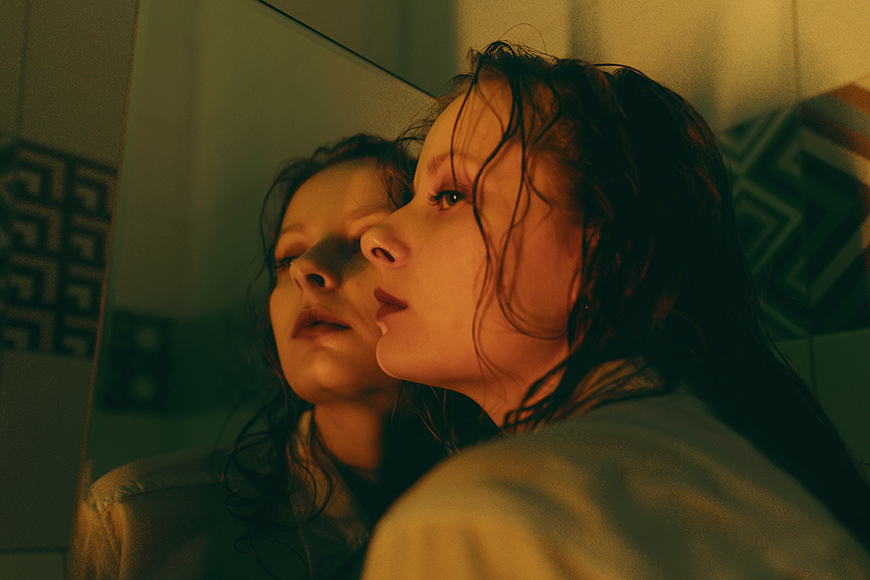
Credit: S. Thevaler
Narrative photography is the act of using a camera to narrate a story and the idea that photography is a good medium for storytelling.
As with all other forms of narration, the person doing it must have a good understanding of context, and what it is they want to portray.
Narrative photography uses a series of thematically linked images to narrate a sequence of events.
Not every event, not every moment is needed to tell the story, that is up to the photographer to decide.
The photographer must choose what to include and what to exclude, and in which order to construct the narrative.
And that narrative doesn’t have to be true. Although photojournalism uses narrative to tell real stories about our world, you can also use photographs to tell fictional stories.
- 25 unmissable pictures that tell a story
Why is narrative important in photography?

Credit: Ricardo Gomez Angel
Sometimes, the visual impact or beauty of a photograph is enough to give it meaning to the viewer. Sometimes the technique the photographer uses is enough to give us pause.
There are many pieces of fine art without a story or narrative to them that can stand alone.
But, many images that have nothing behind them except the desire to be beautiful, or shocking, are ultimately bland. And this is where narrative comes in.
Even single images can have a sense of story to them. The cliché, a picture is worth a thousand words, only holds if there was a reason for the photographer to take the picture and the viewer can feel it.
A sequence of images combined to tell a story can be very powerful, both visually and emotionally.
Looking at a photograph or photographs can automatically create a sense of distance and separation between the photograph and the viewer.
There is the photograph, which is being observed, and the person looking at it, who is doing the observing. There is a gap there, and the less the viewer knows of the context and content of the photograph, the wider the gap is.
A narrative helps to bridge this gap between the image and the viewer. And this is important because it connects the photographs to their audience, the photographer to the viewer, and the viewer to the story told by the narrative.
It is the same connection the reader has with the writer of the book they are reading.
How Much Do You REALLY Know About Photography?! 🤔
Test your photography knowledge with this quick quiz!
See how much you really know about photography...

Your answer:
Correct answer:
SHARE YOUR RESULTS
Your Answers
So, the most important thing narrative should do, beyond creating a connection, is to inspire the viewer’s imagination.
Whether the viewer is seeing a single image or a series, they should want to know more, they should want to seek out more of the story.
What is the difference between narrative and story in photography?
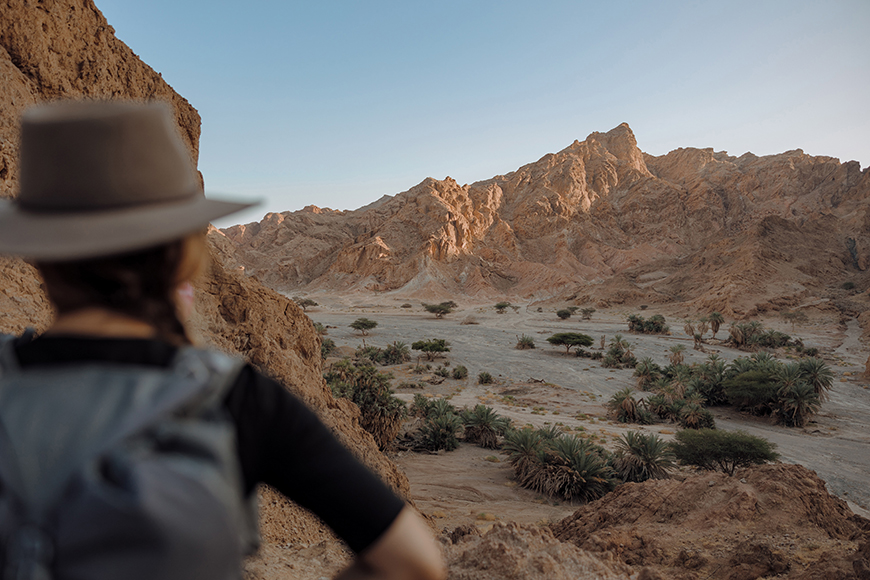
Credit: NEOM
The terms ‘narrative’ and ‘story’ are often used interchangeably, but they are quite different.
The story is the events themselves, the things that happen that have a beginning, middle and an end.
The narrative is the way in which the story is told, the sequence of events, and the structure of the story.
The narrative holds the story together, but the story is the content of the narrative.
If that’s confusing, perhaps the easiest way to remember the difference is to think of it this way:
If you reshuffle the order of events, you have a new narrative of the same story.
6 Examples of Narrative Photography
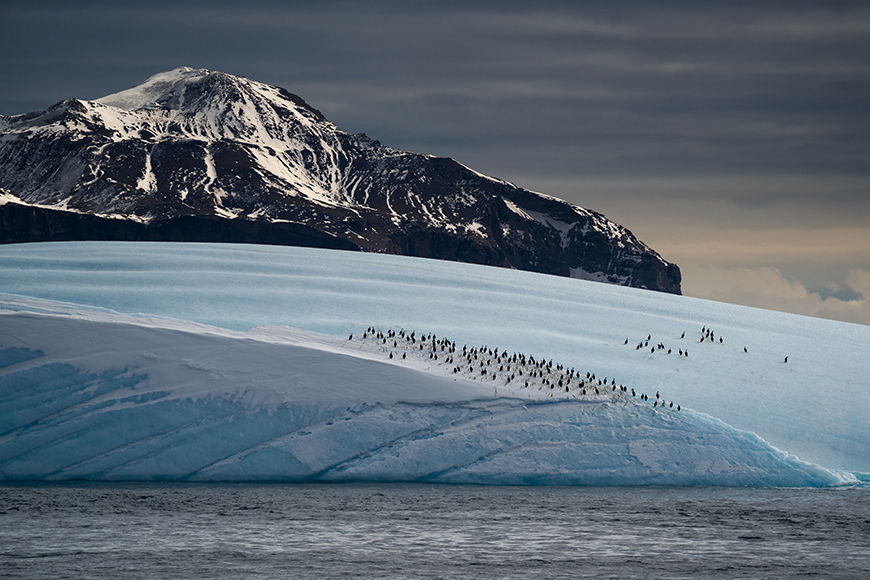
Credit: Bob Brewer

Credit: Alex Shuper

Credit: David Emrich
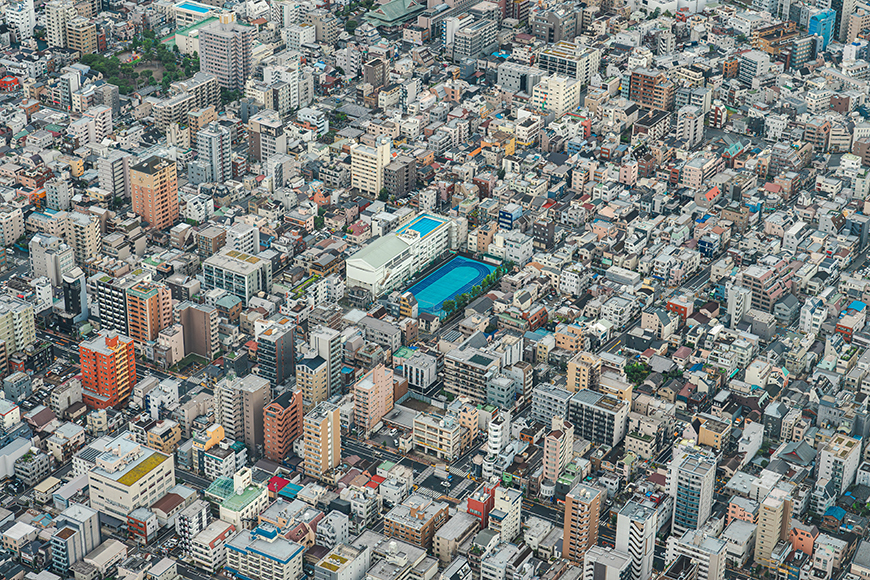
Credit: Taro Ohtani
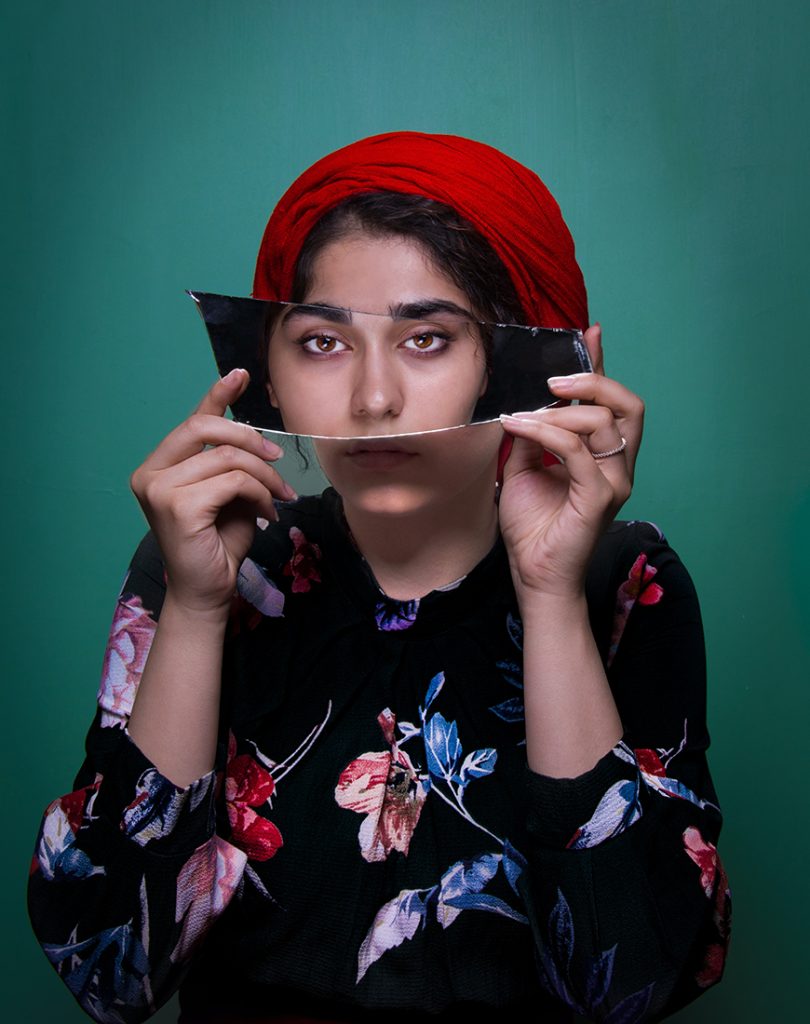
Credit: Amir Geshani

Credit: Ruslan Lissitsa
How Do You Do Narrative Photography? 16 Tips
Here are some tips for telling visual stories using photo essays , a single image or across multiple images.
1. Be original

Credit: Oscar Keys
More than ever, our world and our eyes are drowning in images.
They’re on news sites, advertisements, blogs, and your Facebook feed. It’s a deluge.
And even when the aesthetic quality, or technical ability that has gone into taking the photograph is high, it’s often repetitive.
Plagiarism and unoriginality are rife. Just think of how many millions of unique people who have visited the Leaning Tower of Pisa and come away with exactly the same photograph.
If you want to tell a story with your photographs you need to stand out.
No pressure!
Ideally, you need to try to come up with an idea that no one has seen before, but you could also find a completely new way of telling an old story.
The important thing is that it has to be new. There has to be a reason for people to want to engage with it.
The good news is that just because you’re alive, you’re already halfway there.
You are an original, and only you have the ideas that you have.
So have a think about what those ideas are, and try them out.
2. Do your research
Ask yourself, why are you doing this? And why does this story need to be told?
The answer doesn’t have to be that you want to change the world, or that you want this story to say something profound, it can be as simple as that this story interests you in some way.
You have to have a reason to shoot it. If you don’t, you’ll lose motivation or do it half-heartedly. If you’re not interested in the story and have no emotional connection to the content, that will be translated into the image or images, and they will suffer for it.
But, assuming you know why you want to shoot a particular narrative, you then need to research and plan the shoot.
If there’s a history to your topic, you should be reading about it, if you’ll be shooting in a foreign culture, you’ll need to learn about the customs, and probably some of the language.
If there’s a particular fashion that needs to be followed or a set environment it needs to be shot in, you need to know all about it.
Even if your story will be shot in a more spontaneous, candid style, at a sporting event, or religious festival, for example, you still need to plan.
You need to take care of all the logistics, timetables, travel and accommodation arrangements, and know the weather forecast.
During your research, you can find other photographers who have shot the same event and ask them for tips. They might let you know about things, for example, you’re not allowed to shoot, or protective clothing you might need.
Whatever you’re shooting, you need to prepare meticulously, in a way that is relevant to your subject, and well in advance.
Although planning and researching can sound like rigidity to an artist, when you have a plan in place, it frees you up for the next point.
3. Be spontaneous
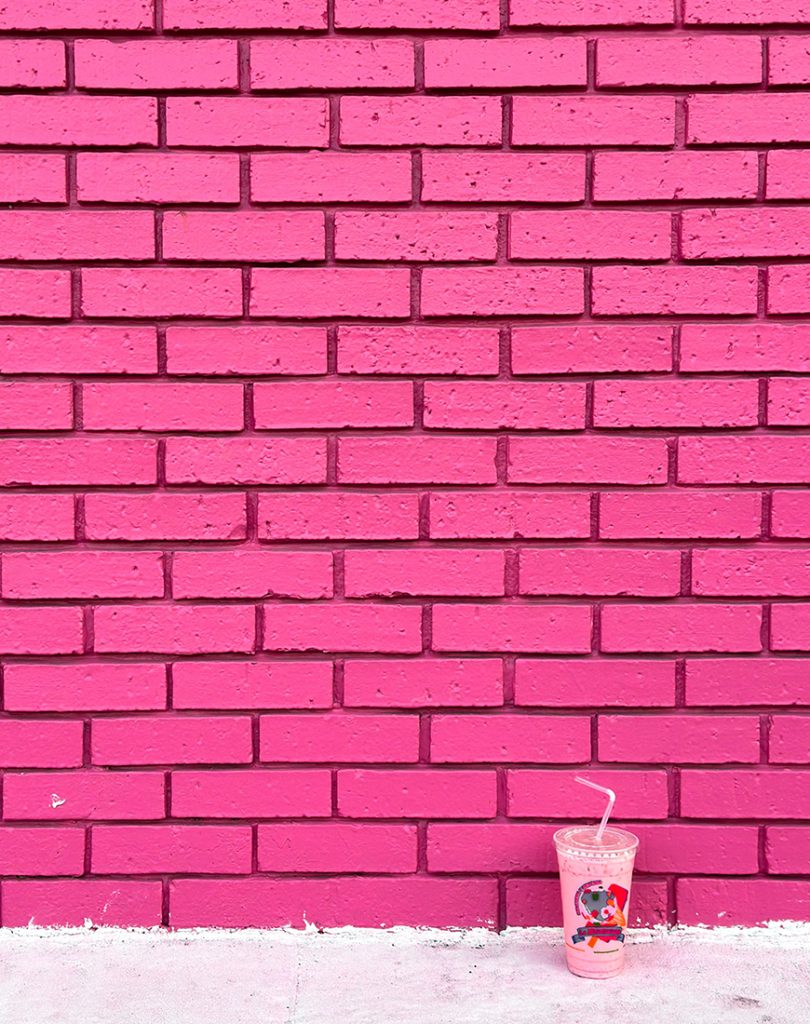
Credit: Elnaz Asadi
Whether your narrative is being shot through a more candid form of photography, such as street photography, or taking place in a highly stylised and controlled environment like a studio, you need to be spontaneous (or at least be open to it).
You can’t control everything. You can plan, you can set your camera settings, you can tell models what to do, and you can get yourself in the right positions, but you must always be alive to the moment.
Trust your instinct, listen to your gut.
If you are storytelling in a fast-paced environment, or a war zone, you need to think fast and adapt quickly to changing conditions.
But even if your shoot is a slower-paced and in a more controlled environment, things may happen that you have no control over, but those might be the things that bring your images to life.
Something might happen to change the direction of your narrative or give it a layer you hadn’t thought of.
If you are closed to these chance happenings, you might miss the story completely. So, have a plan, and do your research, but remember that plans can change, things happen. That, after all, is the nature of stories.
4. Consider your settings and equipment
The camera settings you use will have a great impact on the effectiveness of your narrative.
Think about your depth of field . What do you want to be in focus? What would you like to be out of focus?
As for your shutter speed , how will you use that? Do you want to freeze the action, or use motion blur to infer movement? Blur can also be used, of course, to express other things like, for example, confusion.
Think about how your use of these settings will help you tell the story.
The time of day you choose to shoot in (if your story takes place outside) will also have a great impact.
Naturally, if you are shooting in a studio, the temperature and brightness of the lighting you use will play the same role.
Think about which camera you’ll use, whether you’ll shoot digital or film. And the lens – the focal length is very important.
Telephoto lenses will bring you up close to your subject, whereas wide-angle lenses will allow you to show more of the background or scene – so you need to make sure this is relevant.
Will you overexpose your images? Should you underexpose them?
These are all things you need to think about before you take your photographs, and also when you are taking them.
5. Look for symbolism
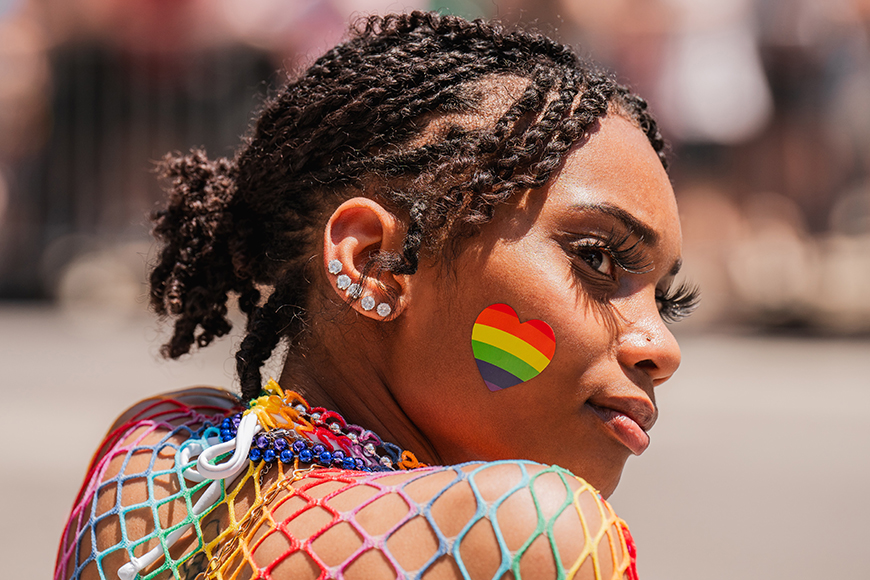
Credit: Mike Cox
This is somewhat related to the third point, spontaneity.
When you are open to what is happening while you are taking photographs, you may start to see symbolic elements you can use in your photographs. Your mind may start to create links.
But this is also true in a more planned sense. When you are planning a shoot, you might want to think of more abstract or symbolic ways in which you can express your story or parts of it.
Literal interpretations can often (although not always) be a little boring.
Think about approaching the narrative from the side, rather than head-on to unearth symbolism in photography.
6. Limit visual distractions
This doesn’t mean that your photographs cannot or should not contain a lot of information, or many focal points (as long as there’s balance).
It just means that you need to eliminate everything from a photograph that’s not relevant to what you want it to express. The image needs to be concise.
If there’s a fish in your image and it doesn’t need to be there, take it out.
7. Pay attention to composition
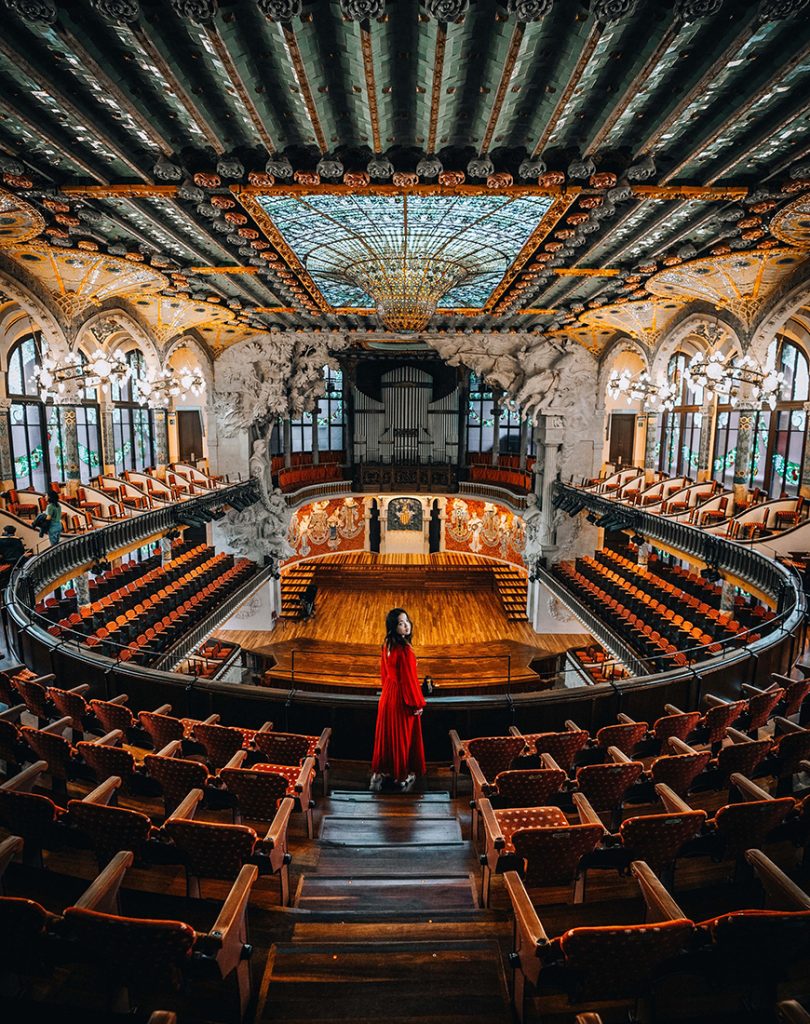
Credit: Joe Yong
This is a basic rule that applies to narrative photography as much as it does to any other type of photography.
You need to consider leading lines , hidden geometry, the rule of thirds, or the use of negative space.
It can be easy when focusing on narrative elements to forget that in order for anyone to look at your story, you must first present them with a balanced image that draws them in.
That’s composition. Your decisions about which compositional rules to adhere to and which to break will be the viewer’s visual introduction to your work, and therefore the element that will decide if they look further and get to be told a story.
8. Convey emotion
Find ways to introduce emotion into the narrative.
There are many ways in which to do this, and these ways will depend greatly on your subject.
Some examples, though, would be in your choice of lighting, colours, exposure settings, or as simple and stark a choice as whether you choose to photograph someone from the front or back.
Finding a way to express conflicting emotions creates tension.
Most importantly, you, the photographer needs to feel emotionally connected to what you’re photographing. Without that, you won’t be able to convey any emotion at all.
9. Use captions
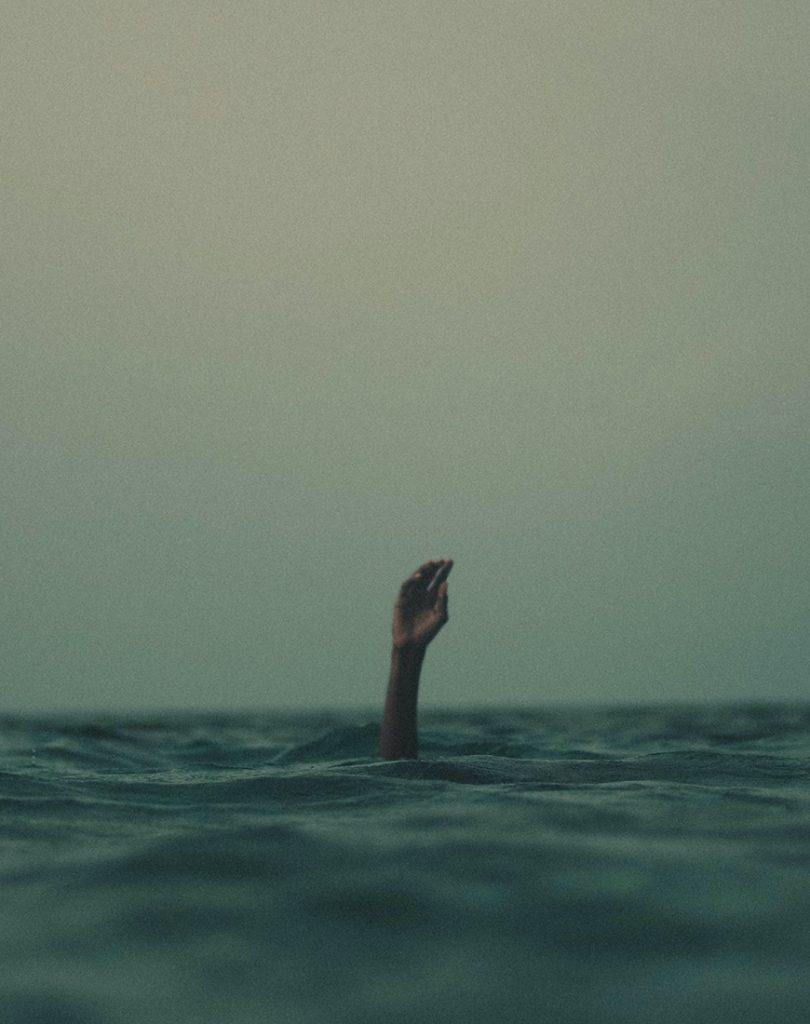
Credit: Mishal Ibrahim
Not all images need captions, but text is a great way to add information or context to a story.
It doesn’t need to be factual, either.
I’ve seen abstract text paired with images and poetry. The main thing is that the text, if you use it, is relevant to and enhances the image or images, without telling the whole story.
10. Shoot a series, shoot a single
Don’t tie yourself to the number of photos you need to produce.
Sometimes, you’ll intend to create a photo series , but everything you need to say can be said in a single photograph.
Other times, you’ll work on a photograph and realise you need to expand on that idea and create a series.
The narrative will tell you what you need to do.
11. Use colours
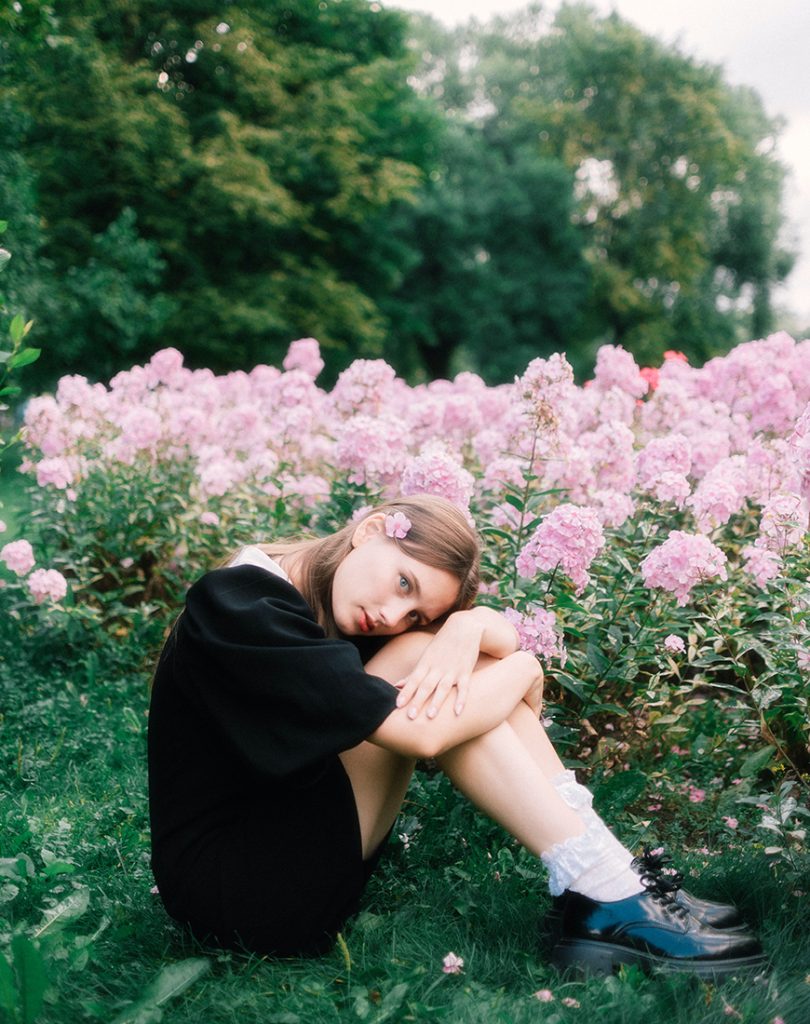
Credit: Polina Shirokova
Colours are an extremely important narrative device.
Blue can be associated with sadness, red with passion or anger, green with envy or the natural world.
Think carefully about how your use of colour impacts your storytelling in photography .
12. Think about perspective
Perspective, too, is loaded with psychological weight.
Choosing where to shoot things will determine how viewers see them on a subconscious level.
For example, if you want to portray a person as confident in your narrative, don’t shoot them from above, as that will show them as vulnerable or weak. Instead, shoot them slightly from below, or if you want them to be overconfident or domineering, get down even lower.
13. Be inspired
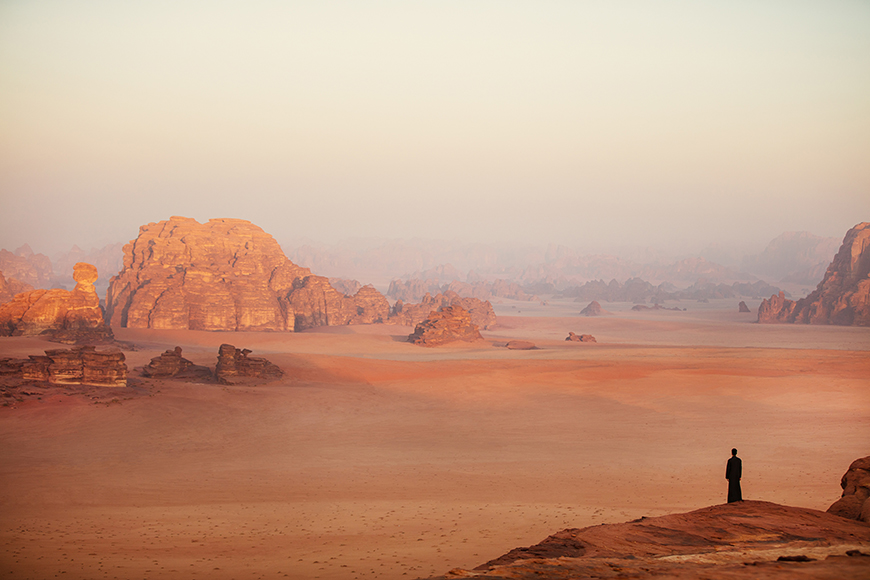
Look at other photographers’ narrative photography work.
Study their images to learn about composition, use of colour, and how they put narratives together.
Also, it’s a good idea to join a photographer’s group, either online or in the flesh.
Talking to other photographers about your ideas and theirs is a great way to get ideas, feedback, and inspiration, and to let air into your work.
By that I mean, take it out of the bubble you put it in.
Often when we create things we do so in a closed room, so to speak, and letting other people see it, and allowing other perspectives on it, can often be the thing needed to drive it forward.
14. Don’t be afraid of failure
Many people are so scared of failure that they don’t do anything. They might have ideas, but they don’t act on them, just in case they don’t work out.
Failure is a natural part of progress, a natural part of narrative photography.
It’s possible your idea might not work. It might need to be changed, or discarded entirely.
But you can always learn from it, and that’s what will help you change your project for the better, or what will give you a better foundation from which to start something new.
Accepting that you might fail, or might already be failing, is actually pretty freeing. It releases tension and frees you from being overcritical about your work.
And if you can then relax into it and just be interested in the outcome of your own story, you’ll enjoy the process more, and your work will be better.
15. Be coherent
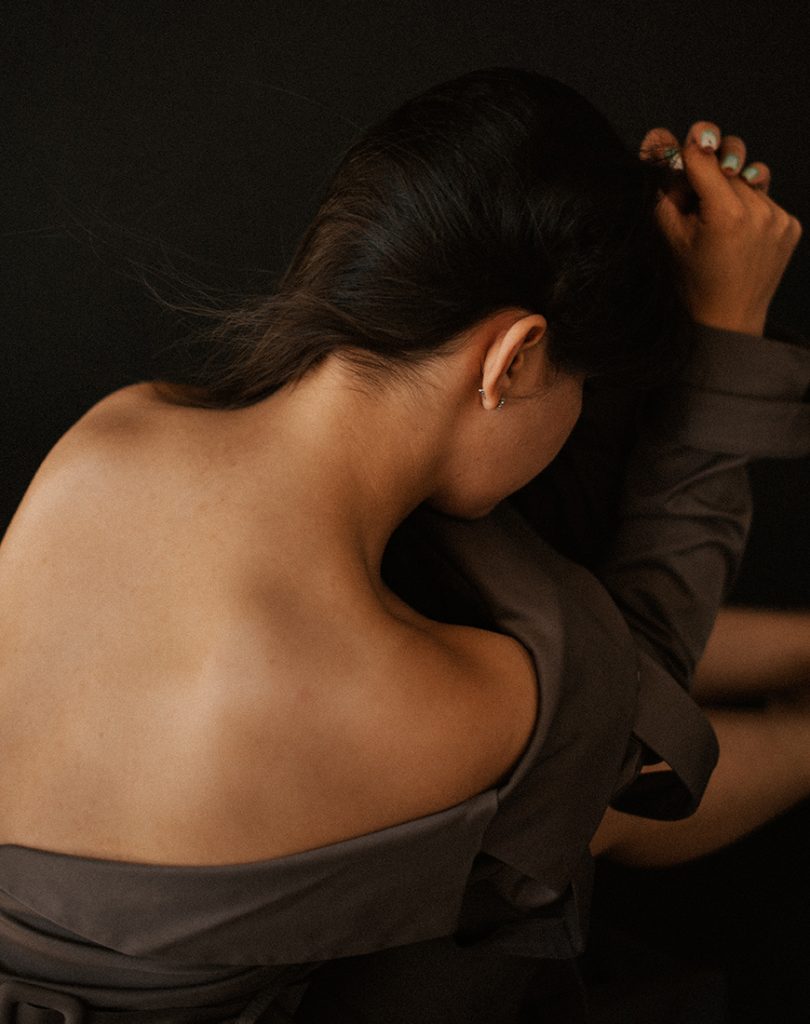
Credit: Kateryna Hliznitsova
This is possibly the most important tip in this narrative photography guide.
Coherence is where the narrative goes to live or die.
The more coherent your idea and execution are, the better chance you have of creating high-quality narrative photography.
For the narrative to work, all your ideas and aesthetic elements need to come together in a tight, complete package, with no fluff or extraneous matter.
That means the composition, use of colour and perspective, the settings you have chosen, and the motivating principle by which you chose the subject, must all clearly have an intention.
And, if all of those elements have been chosen and included with intention, and if everything irrelevant to the expression of the story has been eliminated, you should have something coherent.
Which means, something that is truly itself, and not something else.
16. Give yourself time
Be patient.
Sometimes it can take a long time for a series to come together.
Sometimes things need to be reshot.
Even if you are just trying to take a single photograph, it can take a lot of time for all the elements to come together.
It might need a lot of post-processing.
Sometimes you might get frustrated and need to step away.
But the world is not in a rush to see your narrative photography work, so you shouldn’t rush the process.
Take the time you need to make sure that when you’re finished creating the visual story , you’re happy with it, and wouldn’t want to change anything about it.
Who Is Famous for Narrative Photography?
- Gregory Crewsdon – Best known for staging dramatic scenes of American suburban neighbourhoods and homes
- Robert Capa – A Hungarian-American war photographer and photojournalist who is considered by some to be the greatest in his field
- Ansel Adams – A famous landscape photographer known for his black-and-white images of America
- Henri Cartier-Bresson – Often considered to be the father of modern photography and a master of capturing the decisive moment
- Robert Frank – A chronicler of America and the American way of life, who created iconic images about racial inequality
- Margaret Bourke-White – A documentary photographer who was the first woman to be given credentials to shoot World War II, and the first photographer to be allowed into the Soviet Union
- Dorothea Lange – An American photojournalist and documentary photographer. Her Depression-era photographs are her seminal work
- Walker Evans – Another American documentary photographer whose work humanized the effects of the Great Depression
- Diane Arbus – A photographer who specialized in disturbing, intimate, and disturbingly intimate portraits
- Steve McCurry – A versatile photographer who shoots travel, portraits, and in war zones. One of his photographs, Afghan Girl, is perhaps one of the most famous photos ever taken

Check out these 8 essential tools to help you succeed as a professional photographer.
Includes limited-time discounts.
You'll Also Like These:

As the Content Manager of Shotkit, India Mantle brings with her a lifelong love for photography that she developed during her childhood, watching her father document their family moments with his Nikon EM. In her free time, you find her enjoying the awe-inspiring natural beauty of her home, Northern Rivers, Australia.
Leave a Comment Cancel Reply
👋 WELCOME TO SHOTKIT!

🔥 Popular NOW:

Unlock the EXACT blueprint to capture breathtaking iPhone photos!
Shotkit may earn a commission on affiliate links. Learn more.
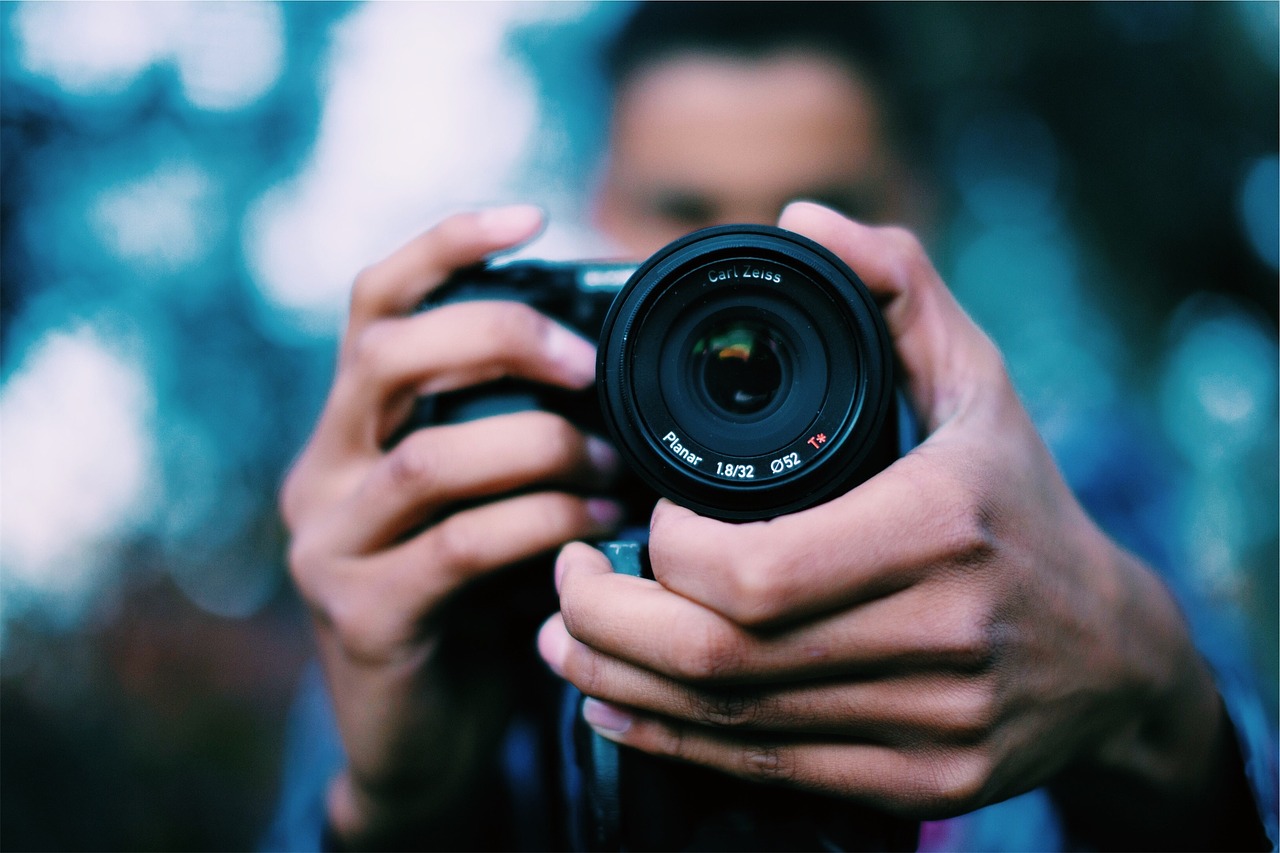
The Photo Essay
About the Genre:
A photo essay is a collection of images that work together to tell a story. As we’ve seen, while photos are often considered incapable of lying because they “quote” from reality rather than altering it, pictures by themselves in isolation (both in time and space) are also often ambiguous and necessarily incomplete. Over time, the subjects of photos become distant and alien to their viewers. John Berger suggests that by creating stories with pictures, we can remedy such ambiguity and alienation by re-creating a “living context” that establishes a field of meaning that makes the photos come to life.
Unlike typical stories (say a written, oral, or video story), however, photo essays can’t provide continuous, seamless narrative meaning, since they are composed of single and “frozen” snapshots. Therefore, the connections between images are always to a certain degree jarring and surprising. It is your job in this photo essay to compose a story that capitalizes on such surprise by helping the viewer see and build connections between your images. Together, they should contribute to a complex web of meaning that stimulates reflection on your topic and shows the things presented in a new and revealing light.
S. Byttebier, PhD/Senior Lecturer
The Shot List (ppt)
Photo essay storyboard
Handout on Captions and Cutlines
Handout on the Photo Essay Introduction
Student Example #1 “London in Color”
Student Example #2 “London: The Isolation of Rich and Poor”

How to create an outstanding Photo Essay
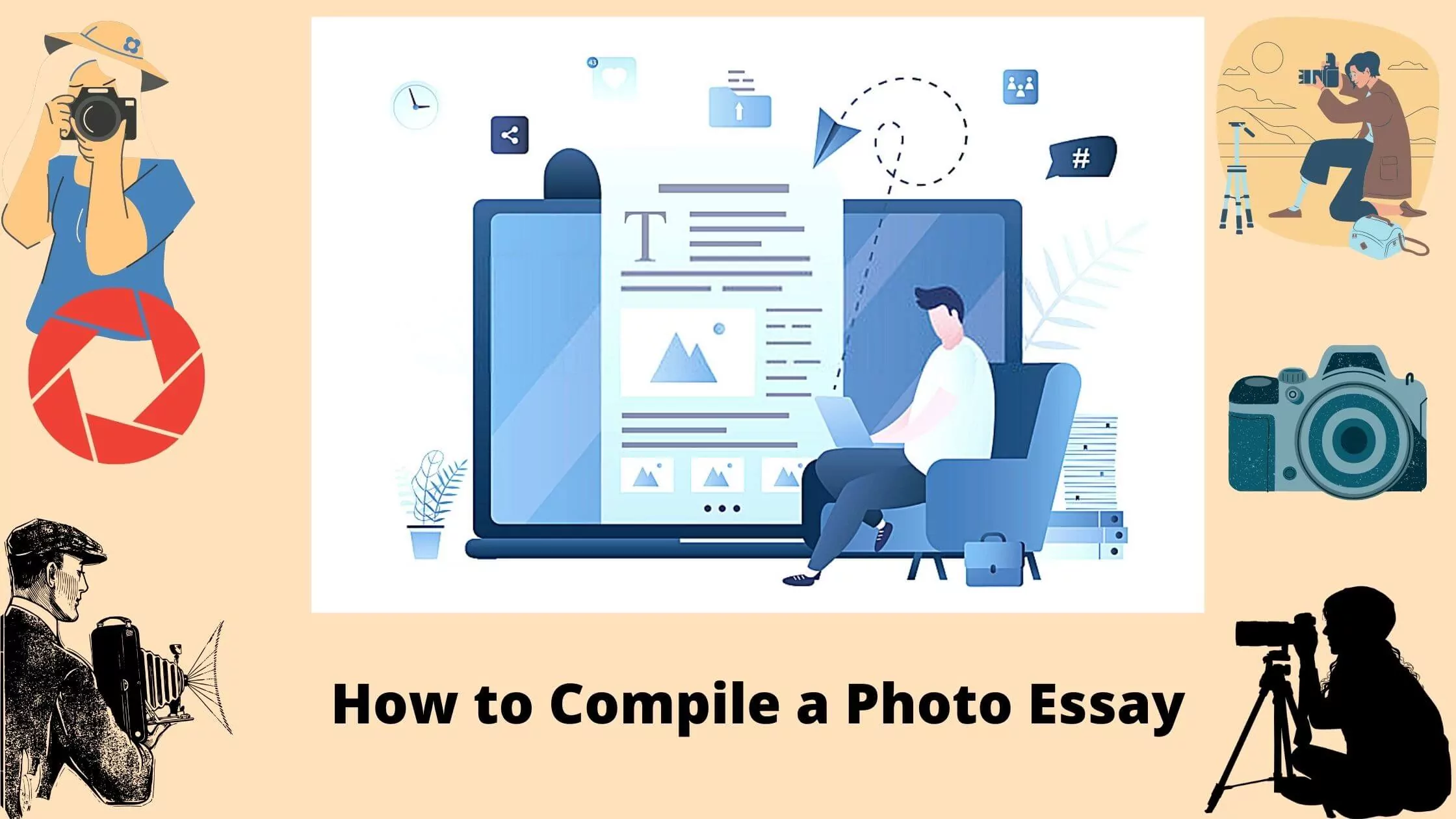
If you are working on your photo essay and would wish to know how to create a successful one, we have some tips, tricks, and techniques outlined in this article. With the sophistication of digital publishing, you need to be on your A-game when creating digital photos that tell a story.
As a custom essay writing service , our ultimate goal in this article is to guide you on creating a photo essay without straining. We like it when writing, and creativity is fun altogether. Therefore, we have outlined examples, classifications, and a framework that you can use when creating your photo essay.
This article also bears the definition of what a photo essay is. And although you could use this as a professional or a student, you can pay someone to do your essay on our website. When you do so, a polished essay writer will work with you in creating a good photo essay,
We have creatives with expertise, a knack for experimentation, critical thinking and creativity, and an insatiable urge to produce top content. If it sounds like you could use our help, let us know the best way we can assist you in creating a perfect photography essay.
If, however, all you need is insights to point you in the right direction, here is how to create a good photo essay without straining. Let’s explore!
What is a Photo Essay?
Visual storytelling appeals to everyone who has a sense of sight.
Unlike your typical essay in college, a photo essay is a project where you present a series of photographs or images to tell a story, share a narrative, or push a theme/agenda. Thus, a photo essay facilitates picture-led storytelling , which is a creative innovation in photojournalism.
It is also known as a photographic or picture essay. A great photo essay powerfully evokes emotions and appeals to the understanding of its intended audience without using words or with minimal words alongside the series of images.
A perfectly-created photo essay narrates a story using many photographs that take the viewer along your narrative journey. Indeed, it proves that a picture is worth a thousand words. In this case, since there are many pictures/images, you could say a photo essay is rich in words, flavor, and content, yet it does not have words.
Talking of photo essays, Ansel Adams is one of the revered and famous photo essayists. Other photo essayists include James Nachtwey, Eugene Smith, and Nancy Borowick .
How to Create a Photo Essay in a step-by-step format
Here is a step-by-step approach to follow to successfully create a compelling and engaging photo essay:
Step 1 – Do your Research
If you are to create an attractive and relevant photo essay, begin by researching the best framework to adopt. Look at what people are doing out there and find out how creatively you can do it better. There are inexhaustible ideas and concepts that you can explore when writing a photo essay. If you’ve not chosen a topic, thorough research can help you decide on a topic and handle it well.
Step 2 - Choose a theme for your photo essay
With the research, you can already identify a specific theme or narrative for your picture essay. Therefore, highlight the theme or narrative, write some notes about the direction you will tackle and how you will reach and satisfy your audience.
Step 2 – Choose a topic that aligns with the theme
Following the findings from your research, choose a great topic. You are not that lucky photo essayist who opportunistically happens upon a story and turns it into a brilliant photo essay. Therefore, you should choose an attractive, reasonable, short, and memorable topic. You are free to select any topic that interests you and one that you find fun to work on. Your chosen theme or narrative can help define the topic for your photo essay.
Step 3 – Pick your subjects
With the theme/narrative and the topic, you can then choose your subjects. These are the people, things, sceneries, or places of central focus in your photography essay.
The subjects are the ones that give your photo essay a voice, strengthen your narrative, and engage the audience.
Step 4 – Select your top images
Define the appropriate number of images that you intend to use when telling the story. For example, if you intend to leave the audience under suspense, choose which images to use and their order of appearance. Your photo essay project does not have to use all your images but the best.
The best way to integrate your theme, narrative, and subjects is to create a storyboard that helps you decide how to tell the story. Then, when you lay your ideas out, a storyboard helps you focus on what is essential, especially when you have little control over a given subject.
Step 5 – ask for insights and input from others
After creating the storyboard, choosing the photos, and writing a narrative or theme statement, you can share it with someone knowledgeable for critique. You should also invite views and comments from another person. Ensure that you give the entire photo cache to the person so that they can choose, then compare with your best photos and tweak your choice accordingly.
Step 6 – Write the captions and text
With everything set, write the accompanying content for your photo essay. As well, make sure you caption each photo to enhance your visual narrative. Nothing is cast in stone here because you can also drop using image captions. You can experiment with lighting, tone, color, composition, angles, and location so that the narrative flows. Also, don’t forget to create introductory messages and closing messages. You need to have your signature introductory and closing images well-decided.
Step 7 – Edit your work
Now that you have created a photo essay, it is now time to edit everything. You can ask for help or rest and do it when you are energetic and objective. If you want a skilled essay writer to write you an excellent narrative to post alongside your photo essay, you can always trust our essay website. We can also edit the narrative to maintain a good flow.
Step 8 – Publish/submit your work
If everything else is okay, convert the photo essay to the correct format and submit or publish it. Remember, photo essays can be a portion of a webpage, a webpage, a document, fashion publication, photo editorial, collage of images, or mixed media.
Helpful Tips when compiling your Photographic Essay
If you are on track to become a photo essayist, you need to grasp the most critical photo essaying tips, techniques, and tricks. Here is some best advice you could use to find a subject for your photo essay.
1. Try to tell a diverse and confident story
When you get out there to tell a story, make sure you do it most awesomely. Understand your target audience, do anything that will resonate with their needs, appeal to their emotions, logic, and thoughts, and leave them musing over your narrative. It is, therefore, vital that you consider what your key message will be and be confident when handling it in your photo essay.
2.Storyboard before building
Architects, surgeons, artists, engineers, you name the profession, all begin with either a sketch, blueprint or a plan to visualize the entire concept or creation before its actualization. In the real of photo essays, you have to be invested right from the beginning. Therefore, you need to create a storyboard that helps you to convert your vision, abstract thoughts, and ideas to a concrete plan that you can execute to succeed in your project. A storyboard also doubles as a shortlist for your photography project.
When storyboarding, you will notice that you take an outsider view, which helps you evaluate how every element fits into the larger picture – your narrative/theme. When doing it, you can discard otherwise burdensome but irrelevant content, which saves you time and leaves you to focus more.
Storyboarding is a critical, creative step when building a perfect photo essay as it ensures the flow to your viewers.
3. Have a visual structure
A contemporary photo essay follows a simple or basic framework that gives your theme direction and scope. Therefore, having a visual structure, marker, or framework helps you transform the photo series into a narrative. For instance, this Growing up young photo essay published in the BBC chooses to have quotes from the subjects running alongside the photos. Likewise, the picture essay done by photojournalist Stefanie Glinski titled One Month in Kabul Under Taliban rule – a photo essay has narrative and captions to further illustrate the themes, content, and narratives.
4. Have a variety of images
To write an exceptional photo essay, ensure that you have as many photos or images as possible. Assemble as much as you think you will need for the project, then use your ruthless photo editing skills to pick the best photos.
Although shedding content hurts, it’s the only best way to achieve the best piece. It is also better to be in a dilemma of which photos to use than wish that you included a specific shot. Having multiple shots ensures that everything is captured. Then compiling your photo series becomes easier.
5. Edit your photos well
When editing, do it ruthlessly. While you cannot be Annie Leibovitz, Stefanie Glinski, or Ansel Adams, you certainly have to up your game to be at par with them. You can either use a professional editor. Alternatively, you can edit your photos using Photoshop, Illustrator, or other image-editing software. Whatever you choose your struggle to be, ensure that you end up with high-quality photos that make sense to your theme or narrative. If you have to refine an image to remove blemish or flaws, use it as long as it ends up fine. Make sure that the focus of each photo is visible and that unwanted areas are cropped out. If you are editing on your own, edit the photos a few days after the shoot to have an objective mind when doing it.
6. Choose the top 10 images
You are not just going to lazily throw images and words all over a structure and have it for the best photo essay out there. Instead, you need to select quality photos that will tell your narrative. Be keen enough to ensure that any photo that makes it to the top 10 list is compelling and poignant. If you notice that you don’t have good equipment to produce or capture quality photos, don’t be afraid to pull in a professional photographer.
7. Use outside input to perfect your choice
When working on a photo essay project, you are not necessarily an island. The photo essayists we’ve mentioned work with teams. You equally need to get a trusted, visually active, and sophisticated individual, professional, or friend to help you.
Have them look at the photos you took and ask them to choose the best. As well, provide them with a written description of your narrative and ask them to select their 10 best photos.
Compare their choice with yours and if they differ, make a point of asking the reason. Listen keenly and tweak your narrative and choice as they most likely reflect what an audience would perceive from the photo essay.
8. Select the best photos from the best
Based on the reasons from your external source (friend, editor, or photographer), select the 10 best photographs to use in telling your story. As well, change the narration if there is a need to tweak it.
9. Write reasonable captions
For your final choice of 10 images, write a befitting caption that will help to enhance your visual narrative. You need to be concise, brief, and clear. If the photos have a strong or exciting background story you wish to run, have the narrative written as content alongside the photos.
However, if you feel like the images can stand alone without captions, don’t beat yourself over it; leave them out. After all, using captions is not a must.
Look at this example of Black Lives Matter Photo Essay (Link to external site).
Apart from the caption, you can add text that contains data, complex metrics, or maps to support your narrative. Using maps can help drive the point home.
10. Focus on the details
Yes, the devil is always in the details. When you eventually display your photo essay to an audience, everybody analyzes it their way. However, when you capture the details, you will take care of each perspective, judgment, and reasoning from your audience. Ensure that you place everything in context and that everything is up to date.
11. Make it fun
Unlike college essays that come with challenges, creating a photo essay should be fun. Therefore, enjoy every bit of the project. Doing so helps you to step up your game, inspire creativity, and relaxes your mind. There is nothing creative and innovative you cannot do in a photo essay with a let loose sort of spirit.
12. Set the scene
When telling a story through photography, you are equally writing your story. Therefore, ensure that you set a scene to capture the moment that appeals to your audience.
For the events that you have no control over, try as much as possible to take photos that match your narrative or theme.
13. Experiment more when taking photos
There is no single bullet to creating an outstanding photo essay. To achieve perfection, let your photo essay express your story in the best way it can. Therefore, you need to test filter effects, use fonts, adjust the visuals, check the contrast, adjust color, hue, and feel, and crop your photos well. With experimentation comes creativity and innovativeness, which birth perfection.
Classification of Photo Essays
In terms of classification, there are two general classes of photo essays where all the genres of photo essays fall. These classes are narrative and thematic.
1. Narrative Photo Essays
A narrative photo essay, as the name suggests, tells a specific story. But, mainly, these types of photo essays tend to tell a peculiar and more direct story.
Unlike thematic photo essays, narrative photo essays give less freedom to the photo essayist. The use of text is to have some sense of completion to the story.
For instance, the 28 Days in Afghanistan by Andrew Quilty published in the SBS is a narrative photo essay that documents the photographer’s experience in the war-torn nation using both text and unadulterated photos.
The picture essay by photojournalist Stefanie Glinski titled One Month in Kabul Under Taliban rule – a photo essay also falls under this category as it highlights her one-month encounter in Kabul.
2. Thematic photo Essays
Thematic photo essays are topic-specific. For example, they can be on politics, pollution, police brutality, global pandemic, poverty, crime, etc.
You have the freedom of choosing the subjects, location, and you do not necessarily have to incorporate text.
An example of a thematic photo essay is the “ They call us bewitched ” picture essay published in the Guardian. We also bumped into the Olympics Photos: Emotion runs high by the NBC News, which we find as an excellent thematic photo essay. Next, look at this Hurricane Katrina photo essay. It is thematic in the sense that it focuses on a natural disaster. Finally, if you want more examples, this photo essay titled “ From Trayvon Martin to Colin Kaepernick ” details the theme of Black Lives Matter/ police brutality.
Typical Photo Essay Examples/Genres to inspire your creativity
- The daily life photo essay – A Day-in-the-life photo essay tells a story about the day-to-day life of a given subject. It could be a lawyer, president, celebrity, farmer, industrialist, pope, student, etc. most of these photographic essays evoke emotions and help the audience enter into the subject's world.
- Transitioning through life photo essay – These are essays that detail photos of how people transform through life. It can be a photo of a celebrity, president, farmer, or famous person since they were young to date.
- Special events photo essays – As the name suggests, these are photo essays on special events, festivities, and occurrences. The events can be weddings, burials, art exhibitions, car shows, auction events, or celebrations. They have very elaborate and relatable background objects that connect to the main idea.
- Family photo essays – These can be photo essays on family members. You can include photos that show how the family has grown or detailing the family tree. They can also be family business photos that detail the leaders assigned roles to family businesses.
- Protest photo essays – These are thematic photo essays that detail how protests occurred and paint a clear picture of the theme of such protests as the Black Lives Matter protests. When creating a protest photo essay, you should have information about the particular protest. Focus on incidents and protests that occurred in history.
- Sports photo essays – Sports essays can be on sports events such as Olympics, Wimbledon, football leagues, or about sportsmen and women. For instance, the Skysports’ picture essay on Diego Maradona titled Diego Maradona: Images of a football Icon .
- Medical Photo Essays – Organizations such as WHO , Universities , or CDC have various examples of medical photo essays. These visual illustrations focus on medical research, medical practice, diseases, and medical breakthroughs.
- Scientific Photo Essays – Like medical essays, these photo essays detail scientific encounters, breakthroughs, inventions, etc.
- Celebrity photo essays – You can create a photo essay on a celebrity.
- Political photo essays are photo essays that capture and narrate political events, history, and news in a series of photographs and narratives. It could be about leftist and rightist politics or geopolitics as well as policy-making.
- War photo essays – Captures the critical and significant elements of conflict, war, and peace. There are many samples online.
- Timelapse photo essays – These are transformational photo essays that capture the changes of a subject through time. They might take longer to develop and can be on buildings, estates, cities, trees, or landscapes.
- Relationship photo essays – This photo essay genre captures the interaction between people, families, and loved ones. It is the most common assignment in journalism class. It offers an excellent chance to capture emotions like love, family, and friendship.
- Poverty photo essays – This genre of photo essays captures poverty from the standpoint of the subject. They can contain infrastructure, housing, amenities, food, water, etc. They are very emotional and can use narratives. They are the same as drought photo essays that capture how the drought has ravaged a geographic region of interest.
- City photo essays – These are photographic essays that capture a city's feel, life, and pleasures. They are thematic in nature and allow you to focus on specific areas, moods, and feeling that such places evoke.
- Education photo essays – Details issues in education. For instance, it can be a photo essay showing the disparity in access, challenges in education, or infrastructure in education. An example is The Many Faces of Learning, published in the Stanford Social Innovation Review. Another one is Embracing Education , published by the Lutheran World Federation.
As long as you can think of any topic, there is always a picture or photo essay genre where it can fall under. Remember, you can be asked to create a photo essay on a Word Document or PDF for class, which is where you get the chance to display your prowess and creativity.
Common Photo Essay Examples
Here are the famous photo essays that you can draw inspiration from:
- Various American Natural Sites by Ansel Adams
- “Everyday” by Noah Kalina
- “Signed, X” by Kate Ryan
- “The Vietnam War” by Philip Jones Griffiths
- “The Great Depression” by Dorothea Lange
Structure/Anatomy of a Photo Essay
Here is a blueprint or skeleton of how a basic photo essay can look like
Introductory text/content
This is where you type the text that explains or introduces the photo essay to your audience.
Signature Image
This is the strongest image that has a visual impact on the story you are running. It should be an image that invites the viewers to your story to be interested in looking further. In simple terms, this is your window, attention grabber, or icon; make it count.
This is the picture of a key player or the main subject of your story. You must ensure that the foreground and background elements reinforce the theme or narrative.
Where the subject is caught in real moments, such as in environmental portraits, is reportedly more compelling. You can use a series of posed portraits as well.
Overall wider view
This is the photograph that gives the viewers a sense of the place or part of the place where the story happens. You use such images to create a scene. It can also be a series of detailed images bundled together to set the scene.
Here, you need to follow up with a photograph that explains the finer details. The photo can be abstract but eye-catching in the sense that it draws the attention of the audience. It should be an image that reveals to the audience some aspect that is otherwise missed in a wider shot. You are allowed to use series of small detail photos as a mosaic in one image .
When defining an action, look for a photograph that shows the main theme in your story. For instance, if it is a Black Lives Matter protest, focus on a photo that captures banners, police, and protesters. Specifically, focus on the most poignant or dramatic images that capture people interacting with one another. You can as well capture gestures or moments that amplify the visual narrative you want to communicate.
Closing Photo and text
This is the powerful closing photograph that lets your audience ponder more about your visual narrative. You can follow it with a text highlighting the thoughts you want the audience to reason with as they come to the end of your photo essay.

Gradecrest is a professional writing service that provides original model papers. We offer personalized services along with research materials for assistance purposes only. All the materials from our website should be used with proper references. See our Terms of Use Page for proper details.

- No products in the cart.
Narrative Photography Guide. Photos That Tell a Story.
My latest video – A Narrative Photography Guide: How to Create Photos That Tell a Story – just went live! I’d love to hear what you think of the ideas in it.
In this short look at narrative photography, I discuss how incorporating narrative photography techniques into your work can create compelling and meaningful photos that tell a story. By arranging elements in your photos, you can make your viewers see a character in a scene, not just a model posing.
#storytellingphotography #narrativephotography #compositionphotography
Narrative Photography Guide
Check out my narrative photography guide. I have been exploring the exciting world of storytelling photography for the past 7 years! It all started when I photographed a group of Mexica dancers and became fascinated with the stories and traditions that they were passing down. This guide is part of my storytelling photography series, where I share my experiences and insights on how to incorporate the art of storytelling in photography.
Compositional Techniques
So what’s the secret to great visual storytelling? It’s all about being coherent! Every element in your composition should fit together logically to create a narrative photo. Trust me, it’s like the glue that holds everything together! In my latest video, I show you some examples of how I’ve improved my photos by making sure the lighting and perspective are coherent with the other elements of the composition.
Visual Language
It’s not just about narrative, it’s also about creating aesthetically pleasing photos. In my storytelling photography series, I demonstrate how I’ve used hidden geometry and framing to draw attention to my subject. Who knew math could be so cool, am I right? This is all part of the art of storytelling in photography.
The Art of Storytelling in Photography
In short, creating a cohesive composition is the first step towards storytelling photography. So grab your camera and go out there to start telling stories with your photos! Who knows, maybe you’ll become as obsessed with it as I am! Don’t forget to check out this narrative photography guide and my storytelling photography series to learn more about incorporating the art of storytelling in photography into your work.
Here are five action points you can take away from this video:
1. Use visual language to tell a story with your photos. Compose elements in your photo to communicate meaning.
2. Create visually coherent images by making sure every element in your composition fits together logically. Every aspect of your composition needs to work together to create narrative photos.
3. Consider the psychology of perspective when taking photos. High angles can make people feel inferior, while low angles can make people seem more powerful and confident.
4. Experiment with hidden geometry and framing to draw attention to your subject and create visually pleasing compositions.
5. Remember that culture, ethnicity, and other variables can affect how people interpret your photos.
Learn Narrative Photography with JP Stones
Join me on one of my award winning Photography Workshops in Mexico.
Watch my free online course: Storytelling for Photographers !
I’ve spent the last 7 years trying to understand how visual language could help me tell better stories. It started when I was photographing a group of Mexica dancers, back in 2017.
The Mexica enjoy lives rich in mythology, tradition and folklore. They have this strong connection to their past, to ancient stories passed onto through the generations. I found all of this fascinating, and wanted to find a way to bring the stories into the images we were creating.
Fast forward 7 years, and this interest in visual storytelling has turned into a bit of an obsession. But there’s a good reason for that: it’s made me a better photographer. And I think I can sum up that change… with just two words.
A photo can be much more than just aesthetically pleasing. You can also compose elements in your photo to communicate meaning. This is visual language, I look at it in more detail in this video.
When I first started playing with visual language, I wasn’t very good. And that’s because my visual communication was all over the place. It got better when it became more coherent. Think of a great communicator: Winston Churchill maybe, Steve Jobs? Whoever popped into your head, they didn’t get that good by making stuff up on the spot. They carefully composed their speeches.
Visual Communication
Visual communication is no different. Every element in your composition should fit together logically. Coherently.A visually coherent image stands a better chance of luring the viewer into a narrative frame of mind. A state that happens when a viewer no longer sees a model in a photo, but instead they see a character in a scene. Get someone to that point… and they’re way more likely to engage with your photo. Let me show you I mean.
I took this photo of Linda about 7 years ago. It’s one of my first Mexica photos, and I was happy with it. I liked the geometry in the pose and the leading lines of the tree. But looking at it now, I see a giant issue with the visual language. The image was taken at sunset, but my strobe was set to 5000k. That’s a color temperature for the midday sun, not the setting sun.
In other words, the lighting is incoherent with the rest of the scene. It’s not logical. Photos like this can’t be narrative photos because you see a mode posing, not a character. Here is a more recent image, where I made sure to match color temperatures. That’s why it’s immersive, it’s a more believable narrative photo. This isn’t just about lighting though, it’s about every aspect of your composition. They all need to work together to create narrative photos.
Photograph with Intention
My intention with this image was for Linda to radiate confidence and power. But I messed up, I shot her from a high angle. The psychology of perspective tells us that when you literally look down on someone you also figuratively do that. You feel superior to them. Someone you are looking down on is not radiating confidence or power. It doesn’t matter how you set the lights or the pose up. It won’t work. The perspective isn’t coherent with the other elements of the composition like the pose.
A few months later, I had the chance to reshoot this. Notice how your perception of Linda shifts as I change to a lower perspective. That’s because the visual language becomes more coherent. The confident pose paired with a complimentary perspective.
These sound like totally different issues: color temperature and perspective. But both images were improved by thinking about coherent visual language.I’m not saying every photo should tell a story. Composition can be a purely aesthetic exercise. Most of the time I’m just trying to arrange elements into visually pleasing compositions. And not much else. But sometimes I want to add ANOTHER layer. To create compositions that have aesthetic value and narrative value. Photos that look pretty and transfer meaning.
Narrative Photography
Take this photo. We shot it a few weeks ago. It’s a dramatic take on the Mexica New Sun Ceremony. Every 52 years, the yearly calendar and the shorter Ritual Calendar end on the same day. On that day, the story goes, the Aztec God of Fire Xiuhtecuhtli, binds these two calendars together to create a new sun.
Cohesive Compositions
It’s a great story, and this photo is an attempt at communicating those ideas visually. The fire of course is because the subject is Xiuhtecuhtli the God of Fire. The two torches arc together to symbolize this binding of calendars. The semi-circle created is the shape of a rising sun, or a New Sun.
So, that’s the narrative side of the composition, but there is also an aesthetic side. That semi-circle is a strong geometric shape. Hidden geometry is a well established compositional technique. I love doing this.
It’s been going on for eons.
I also used the fire pots to help frame the model. Framing is another aesthetic trick that draws attention to your subject.
What you get from reading this image is going to depend on your culture, ethnicity and other variables.
I’m not claiming you can read an image like a book.
But if you work on creating cohesive compositions, you’re taking a solid first step towards narrative photography. To have people see characters, not just another model posing.
No Comments
Sorry, the comment form is closed at this time.
Automated page speed optimizations for fast site performance

- Book Reviews
- Video Interviews
- LensCulture Discoveries
- Winners Galleries
- Festival Videos
- Free Guides
- Project Reviews
- Jury Members
- Exhibitions
- Photography Awards
- Stay Updated

Feature Single Frame Narrative Photography: An Essay The world’s most iconic images linger in our minds, inviting us to create further stories and worlds from the moments captured therein. Why? This essay offers a single frame and an explanation. Photograph and text by W Scott Olsen View Images
My heart believes this is true.
A young woman sits on a chair outside a café in Fargo, North Dakota. It’s summer and lunchtime in a college neighborhood. Groups of friends, co-workers, romantic couples all enter or exit the café, yet this woman is alone. She is elegantly dressed. She does not watch the men and women who walk or linger near her chair. Her gaze is down the street. It’s possible she’s watching someone walk away or taking a seat to rest after some difficult conversation. It’s more likely she’s waiting for someone to arrive. She wears a wedding ring. Perhaps a friend. Perhaps a date.
I am lucky to get a photograph.
Why do I find the picture of this woman compelling? She is the only one on the street this day who seems to be living a question. I don’t know any of the people who walk by her, they are as mysterious to me as Europa, but looking at them I also don’t wonder. I know their stories well enough. This woman, though, wants something, waits for something. I have no idea what that something may be. She opens a space for me to wonder.
I am told there is no such thing as single-image narrative photography. There are moving pictures, yes. Movies can tell a story. And a series of photos can tell a story as people and things in the pictures change places—even a diptych will be enough. But a single image is, by definition, “still” photography. Still is the opposite of narrative, right?
Permit me to come at this from a different point of view. I remember reading, somewhere in high school, a wonderful short story written by Ring Lardner about 1925 titled “Haircut.” The story is a monologue by a barber, written in the second person (“you”) as if you—the reader—are in the barber’s chair and he’s telling you stories. However, you realize very soon that the barber doesn’t get it. He is either morally blind or just plain dense. Very soon you—the reader—understand more than any information that’s actually on the page. So here is a question—where is the story? A literary critic would tell you the real story is in the reader’s head. I remember being thrilled when I realized what a reader was actually doing and there are actually as many versions of “Haircut” as there are people who have read it.
In literary studies there is a whole field called ” Reader-response ” that takes up this question. The reader/viewer/listener is central to art-criticism in every form. And we can expand how we understand the act of taking photographs from listening to our colleagues who are writers, musicians, painters, dancers.
As a writer, I have learned about the cadence of sentences from my years as a drummer. As a photographer, I have learned about composition from my years as a writer, populating stories and essays with minor characters, subplots, settings, dramatic tension. In writing, these elements all enhance the narrative.
This is important because so many people believe there is no such thing as single-image narrative photography. I disagree. Not only do I think the single-image can be narrative, I think to believe so changes everything about how we can seek out and compose a photograph.
Think about the famous Steve McCurry photograph ” Afghan Girl .” Why is that picture so compelling? It’s a headshot—nothing more. The traditional garb is a nice touch, yes. And she’s got great eyes. Technically, the lighting is nice and the cropping highlights the eyes. All pretty normal stuff. But we cannot stop looking at that picture. Why?
The reason is all the information we—the viewers—bring to the photograph. This is a young woman in Afghanistan, during war, in a place that does not value women. We think she looks afraid, worried, terrified. Of what might happen? Of what she’s already seen? Both? We don’t know—and that not knowing is exactly the point. We fill in the narrative with our own understandings. The power of the photograph is not only in the photograph itself. That photograph provokes a type of wondering I am going to call narrative.
Think of another icon, the 1947 Robert C. Wiles photo of Evelyn McHale after she had jumped from the observation deck of the Empire State building. Her body crushed the top of a limousine, yet she looks perfectly composed. Her face looks serene. Her clothes are unruffled. Why is this photo so good? In our minds, the distance between how she looks and what we’re really seeing needs to be resolved. We can’t help but wonder who she was, what brought her to despair, what caused her to jump. Intuitively, we believe we would have liked this woman. We try to imagine her life. We create a narrative that may or may not be true—that part doesn’t matter. Looking at the photo, we tell ourselves a possible story.
Think of the painting, ” Landscape With the Fall of Icarus ,” by Pieter Bruegel. We know the Icarus and Daedalus story, but the painting catches us by surprise. That tiny little splash in the corner is not how we imagined it would be. We are forced to create a new, more detailed, more troubling narrative. And who is this guy in the center of the frame, head down, tilling his field, who is missing everything? What we think we knew is completely redone.
Think of the Edward Hopper painting ” Nighthawks .” Who are these people? How did they come to be there? We linger, wondering, creating a story.
Narrative does not mean drama. A picture of an eagle grabbing a fish out of some lake is dramatic and engaging, but there isn’t a bit of that story we don’t already know. Likewise, narrative does not mean the ability to create a deep emotional response. A picture of some wonderful mountain range will always make me pause, mostly because I live on the flatland prairie, and a picture of a supercell thunderstorm or a person hanging over a chasm will make me inhale and wish I was there, but I don’t wonder when I look at those photos as much as I feel.
Writers talk about narrative using terms like “forward motion.” And for photography I think that’s close, though it would be easy to think every picture of someone running or otherwise at speed is a narrative, which I think is wrong. The wonderful (and now cliché) picture of someone leaping over a puddle shows someone in motion but usually fails to make the viewer wonder what came before, what comes after, and why. In writing, we talk about the difference between anecdote and story. An anecdote is only what happened. Guy leaps over puddle and makes it or does not. A story is why that moment is important. A story takes that leap and puts it in the context of some larger, deeper question.
So often about the best photography we say the photographer “caught a moment.” We invoke Henri Cartier-Bresson and the inevitability of a decisive moment. Listen to those words: “caught” implies motion in some larger, ongoing story; “decisive” implies a moment of change, of import, of history in a narrative arc that begins before the photograph and continues after—not present in the image but certainly present in the mind of the audience. Nothing about any single-image can be called “decisive” unless we have an awareness of the larger narrative.
To say there is something called “narrative, single-image photography” does not diminish other types of photography. In fact, it is likely a mistake to think of narrative photography as something separate from the other types. It’s best to think of narrative as a potential element of all photography. A studio portrait can have a narrative element, even if it’s very small. (Quick: why do we love the Mona Lisa? Maybe because we wonder about the motivation for her smile—we are compelled to create a narrative.)
Landscape photos can have a narrative element, as can architectural and nature pictures. A meteorologist may see in a thunderstorm photo a whole world of forces moving, twisting, changing, creating a narrative none of the rest of us see. Certainly, street photography and photojournalism have the most innate possibilities for stories, but they can just as easily serve only as evidence or anecdote. Think of photos from Iraq and Vietnam. And then think of photos from Barcelona or Rio. Photojournalism often offers an act of storytelling. Street photography’s narratives rely on either inherent mystery or on the viewer’s understanding of context.
So, here is what my heart believes: narrative photography is the ability—and intent—to photograph an open question. To quote Kurt Vonnegut, speaking about writing: “Every character should want something, even if it is only a glass of water.” As photographers, it’s possible to capture that wanting.
Narrative photography is the intent to capture a question and invite the viewer to wonder the world of possible answers.
—W. Scott Olsen
W. Scott Olsen is a professor of English at Concordia College in Moorhead, Minnesota, where he also edits the literary magazine Ascent . His most recent book is A Moment with Strangers: Photographs and Essays at Home and Abroad .

W Scott Olsen
United states.

Stay connected to the global photography community

- Scriptwriting
What is a Narrative Essay — Examples, Format & Techniques
I was in the Amazon jungle the first time I wrote a narrative essay, enlightened and enraptured by the influence of ayahuasca. That’s not true. I’ve never been to South America nor have I ever taken ayahuasca. The purpose of that opening is to show how to craft a narrative essay intro — hook, line, and sinker. Narrative essays rely on hooking the reader, and enticing them to read on. But what is a narrative essay? We’re going to break down everything you need to know about these essays — definition, examples, tips and tricks included. By the end, you’ll be ready to craft your own narrative essay for school or for publication.
What’s a Narrative Essay?
First, let’s define narrative essay.
Narrative essays share a lot of similarities with personal essays, but whereas the former can be fictional or non-fictional, the latter are strictly non-fictional. The goal of the narrative essay is to use established storytelling techniques, like theme , conflict , and irony , in a uniquely personal way.
The responsibility of the narrative essayist is to make the reader feel connected to their story, regardless of the topic. This next video explores how writers can use structural elements and techniques to better engage their readers.
Personal Narrative Essay Examples With Essay Pro
Narrative essays rely on tried and true structure components, including:
- First-person POV
- Personal inspiration
- Focus on a central theme
By keeping these major tenets in mind, you’ll be better prepared to recognize weaknesses and strengths in your own works.
NARRATIVE ESSAY DEFINITION
What is a narrative essay.
A narrative essay is a prose-written story that’s focused on the commentary of a central theme. Narrative essays are generally written in the first-person POV, and are usually about a topic that’s personal to the writer. Everything in these essays should take place in an established timeline, with a clear beginning, middle, and end.
Famous Narrative Essay Examples
- Ticker to the Fair by David Foster Wallace
- After Life by Joan Didion
- Here is a Lesson in Creative Writing by Kurt Vonnegut
Narrative Writing Explained
How to start a narrative essay.
When you go to sleep at night, what do you think of? Flying squirrels? Lost loved ones? That time you called your teacher ‘mom’? Whatever it is, that’s what you need to write about. There’s a reason those ideas and moments have stuck with you over time. Your job is to figure out why.
Once you realize what makes a moment important to you, it’s your job to make it important to the reader too. In this next video, Academy Award-nominated filmmaker J. Christian Jensen explains the power of the personal narrative.
Narrative Writing and the Personal Narrative Essay • Video by TEDx Talks
Anything and everything can be the topic of your essay. It could be as benign as a walk to school or as grandiose as a trip to the moon — so long as that narrative exists within reality. Give your thoughts and opinions on the matter too — don’t be afraid to say “this is what I think” so long as it’s supported by storytelling techniques. Remember, never limit yourself as a writer, just keep in mind that certain topics will be harder to make engaging than others.
Narrative Essay Outline
How to write a narrative essay.
First step, game plan. You’re going to want to map out the story from beginning to end, then mark major story beats in your document.
Like all stories, your narrative essay needs a clear beginning, middle, and end. Each section should generally conform to a specifically outlined structure. For reference, check out the outline below.

Narrative Essay Format • How to Write a Narrative Essay Step by Step
Make sure to reference back to this outline throughout the writing process to make sure you have all your major beats covered.
Purpose of narrative essay writing
Narrative essays give writers the ability to freely express themselves within the structure of a traditional story. Nearly all universities ask applicants to submit a narrative essay with their formal application. This is done for two reasons: they allow institutions to judge the linguistic and grammar capabilities of its applicants, as well as their raw creative side.
If you’re considering studying creative writing in an undergraduate or graduate program, then you’re going to write A LOT of narrative style essays. This process may seem indomitable; How am I supposed to write hundreds of pages about… me? But by the end, you’ll be a better writer and you’ll have a better understanding of yourself.
One thing that all successful essayists have in common is that they make radical, often defiant statements on the world at large. Think Ralph Waldo Emerson, Virginia Woolf, and Langston Hughes for example.
Being a professional essayist isn’t easy, and it’s near-impossible to be one who makes a lot of money. Many essayists work as professors, editors, and curriculum designers as well.
This next video features the late, award-winning essayist Brian Doyle. He explains all the things you need to hear when thinking about writing a story.
Narrative Essay Examples “Lecture” via Boston University
We can learn a lot from the way Doyle “opens” his stories. My favorite is how he begins with the statement, “I met the Dalai Lama once.” How can we not be interested in learning more?
This brings us all the way back to the beginning. Start with a hook, rattle off the line, then reel in the sinker. If you entice the reader, develop a personal plot, and finish with a resolute ending, you’ll have a lot of success in essay writing.
Up Next
Narrative essay topics.
We've curated a collection of narrative essay topics that will spark your creativity and bring your experiences to life. Dive into the rich tapestry of your memories, explore the unique threads of your life, and let your narrative unfold.
Up Next: Narrative Essay Topics →
Write and produce your scripts all in one place..
Write and collaborate on your scripts FREE . Create script breakdowns, sides, schedules, storyboards, call sheets and more.
- Pricing & Plans
- Product Updates
- Featured On
- StudioBinder Partners
- The Ultimate Guide to Call Sheets (with FREE Call Sheet Template)
- How to Break Down a Script (with FREE Script Breakdown Sheet)
- The Only Shot List Template You Need — with Free Download
- Managing Your Film Budget Cashflow & PO Log (Free Template)
- A Better Film Crew List Template Booking Sheet
- Best Storyboard Softwares (with free Storyboard Templates)
- Movie Magic Scheduling
- Gorilla Software
- Storyboard That
A visual medium requires visual methods. Master the art of visual storytelling with our FREE video series on directing and filmmaking techniques.
We’re in a golden age of TV writing and development. More and more people are flocking to the small screen to find daily entertainment. So how can you break put from the pack and get your idea onto the small screen? We’re here to help.
- Making It: From Pre-Production to Screen
- What are the 12 Principles of Animation — Ultimate Guide
- What is Pacing in Writing — And Why It’s So Important
- What Does O.S. Mean in a Script & How to Use It
- What Does a Leadman Do in Film — Job Description Explained
- What is a Unit Production Manager — Job and Role Explained
- 1 Pinterest

IMAGES
VIDEO
COMMENTS
A photo essay is a form of visual storytelling that develops a narrative across a series of photographs. It originated during the late 1920s in German illustrated journals, initially presenting stories in the objective, distanced tone of news reporting. The photo essay gained wide popularity with the growth of photographically illustrated magazines such as VU (launched in Paris in 1928), LIFE ...
A good photojournalist harnesses this potential to confront viewers with the reality of pain, injustice or whatever his or her story incorporates. Indeed a successful and factual photo essay has the potential to bring about social change, provoke lawmakers in to changing laws, and even end wars. An effective and successful essay produces an ...
3. Take your time. A great photo essay is not done in a few hours. You need to put in the time to research it, conceptualizing it, editing, etc. That's why I previously recommended following your passion because it takes a lot of dedication, and if you're not passionate about it - it's difficult to push through. 4.
The idea of a photo essay is to create a whole, not a bunch of random parts. Think gestalt. The images must interact with each other. Repetition helps achieve this end. Recurring themes, moods ...
⬥ Narrative A narrative photo essay is much more specific than thematic essays, and they tend to tell a much more direct story. For instance, rather than show a number of scenes from a Great Depression Era town, the photographer might show the daily life of a person living in Dust Bowl America. There are few rules about how broad or narrow ...
Even the dictionary definition of "photo essay" includes using images to convey either a theme or a story. But in my experience, a photo essay and a photo story are two different things. ... Some people categorize photo essays as either narrative or thematic. That's essentially just calling photo stories "narrative photo essays" and ...
Written by MasterClass. Last updated: Jun 7, 2021 • 5 min read. Photo essays tell a story in pictures, and there are many different ways to style your own photo essay. With a wide range of topics to explore, a photo essay can be thought-provoking, emotional, funny, unsettling, or all of the above, but mostly, they should be unforgettable.
Decide how much time you are going to give to making the photographs and choose a deadline. After that date you will be making a final selection and post processing the images. Write out a list of the photos that you want to make in that time frame. Think and plan the lighting.
Photo packages are the sophisticated cousin of essays: they take photo storytelling to another by requiring supplementary text. A person needs more explanation to fully understand what the ...
A photographic essay or photo-essay for short is a form of visual storytelling, a way to present a narrative through a series of images. A photo essay delivers a story using a series of photographs and brings the viewer along a narrative journey. Examples of photo essays include: A web page or portion of a web site.
The Photo Essay as a Persuasive Narrative. The photo essay is a persuasive narrative, the visual details of which show a subject, theme, and sense of purpose. For example, one of the most famous ...
Photo Essay. Term: Photo Essay. Description: A photo essay is a captivating visual storytelling technique that utilizes a sequence of carefully curated photographs to convey a narrative, evoke emotions, or shed light on a particular theme or subject. It is a powerful medium for photographers to communicate their perspectives and convey a deeper ...
Samuka Marinho is an illustrator, photographer, photo editor, and the creator of Corsários, a 192-page photographic narrative that tells the story of the so-called Golden Age of Piracy with more than 400 richly crafted scenes. In this online course, learn to develop a visual narrative alongside Samuka, who walks you through the entire process ...
A photo essay is a narrative that uses a group of images to tell a story or emphasize a specific concept. The camera plays a utilitarian role and is pretty far from what the final result can convey to those who read it (either completely or just partially). Being a narrative in a very holistic form, the essay should include the following ...
Photo Essays. A photo essay is an excellent format for a chronological narrative, showcasing a series of images that build upon each other to tell a complete story. They often start with a wide establishing shot and progress through medium and close-up photos, showing various perspectives and details, much like chapters in a book. Photographs ...
Narrative photography is the act of using a camera to narrate a story and the idea that photography is a good medium for storytelling. As with all other forms of narration, the person doing it must have a good understanding of context, and what it is they want to portray. Narrative photography uses a series of thematically linked images to ...
The Photo Essay. About the Genre: A photo essay is a collection of images that work together to tell a story. ... we can remedy such ambiguity and alienation by re-creating a "living context" that establishes a field of meaning that makes the photos come to life. Unlike typical stories (say a written, oral, or video story), however, photo ...
1. Narrative Photo Essays. A narrative photo essay, as the name suggests, tells a specific story. But, mainly, these types of photo essays tend to tell a peculiar and more direct story. Unlike thematic photo essays, narrative photo essays give less freedom to the photo essayist. The use of text is to have some sense of completion to the story.
1. Use visual language to tell a story with your photos. Compose elements in your photo to communicate meaning. 2. Create visually coherent images by making sure every element in your composition fits together logically. Every aspect of your composition needs to work together to create narrative photos. 3.
This essay offers a single frame and an explanation. My heart believes this is true. A young woman sits on a chair outside a café in Fargo, North Dakota. It's summer and lunchtime in a college neighborhood. Groups of friends, co-workers, romantic couples all enter or exit the café, yet this woman is alone. She is elegantly dressed.
Step 1: Read the Where We Are series closely. Step 2: Decide what local community will be the subject of your photo essay. Step 3: Take photos that show both the big picture and the small details ...
A narrative essay is a prose-written story that's focused on the commentary of a central theme. Narrative essays are generally written in the first-person POV, and are usually about a topic that's personal to the writer. Everything in these essays should take place in an established timeline, with a clear beginning, middle, and end.
When applying for college, you might be asked to write a narrative essay that expresses something about your personal qualities. For example, this application prompt from Common App requires you to respond with a narrative essay. College application prompt. Recount a time when you faced a challenge, setback, or failure.